SHAPES
OF
GREEK VASES

Project Gutenberg's Shapes of Greek Vases, by The Metropolitan Museum of Art This eBook is for the use of anyone anywhere in the United States and most other parts of the world at no cost and with almost no restrictions whatsoever. You may copy it, give it away or re-use it under the terms of the Project Gutenberg License included with this eBook or online at www.gutenberg.org. If you are not located in the United States, you'll have to check the laws of the country where you are located before using this ebook. Title: Shapes of Greek Vases Author: The Metropolitan Museum of Art Release Date: July 18, 2019 [EBook #59946] Language: English Character set encoding: UTF-8 *** START OF THIS PROJECT GUTENBERG EBOOK SHAPES OF GREEK VASES *** Produced by Richard Tonsing, Turgut Dincer and the Online Distributed Proofreading Team at http://www.pgdp.net (This file was produced from images generously made available by The Internet Archive)
Transcriber’s Note:
The cover image was created by the transcriber and is placed in the public domain.

The appreciation of beautiful form, with the ability to create it, which was characteristic of the Greek people, is nowhere better illustrated than in the shapes of their pottery. These vases—the jars, dishes, and cups made for household and religious use—were designed with intelligent skill to serve their purpose in the most effective fashion, and are valued for their fine shapes no less than for their interesting and beautiful decoration.
The following reproductions of the most important shapes in use among Athenian potters during the sixth and fifth centuries B. C. will show with what care the relation of the height to the width and the proportion of the parts to the whole were designed with a view to harmonious effect, and how skilfully the forms of the neck, the mouth, and the foot, and the position of the handles were planned for practical use.
The vases have been selected where possible from the collection in this Museum; but when a certain shape was not represented here or conspicuously better examples were available elsewhere, vases in other collections have been included. Unless otherwise stated the vases here illustrated are in this Museum.
5AMPHORA. Two-handled jar for holding provisions.
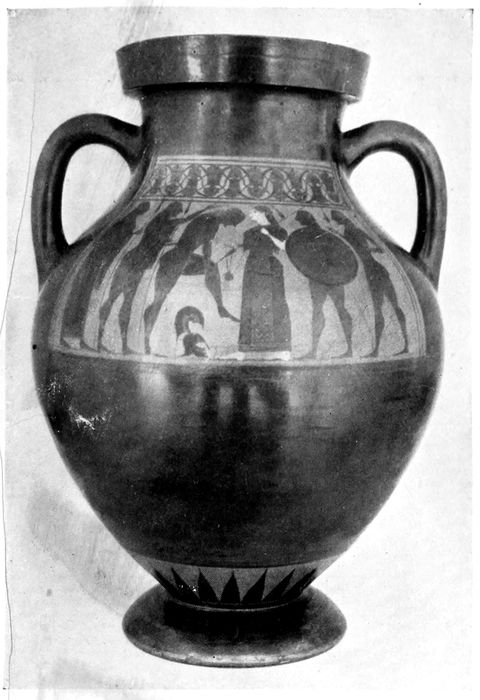
Black-figured type with heavy lip and cylindrical handles. The decoration is usually painted in panels, back and front, the rest of the body being black.
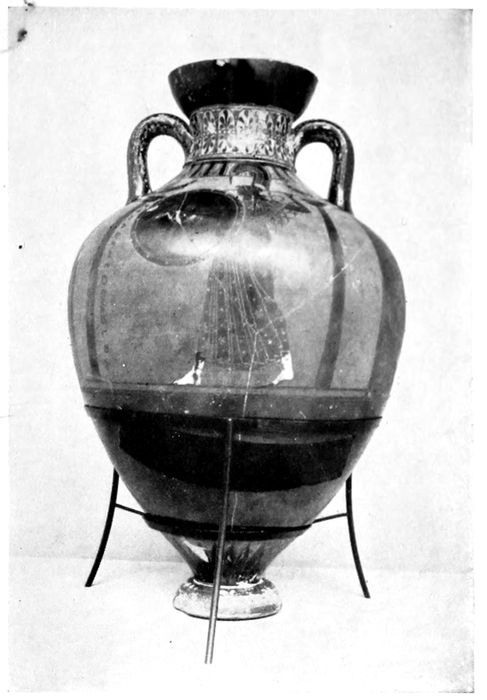
Panathenaic amphora given as a prize in the games at Athens.
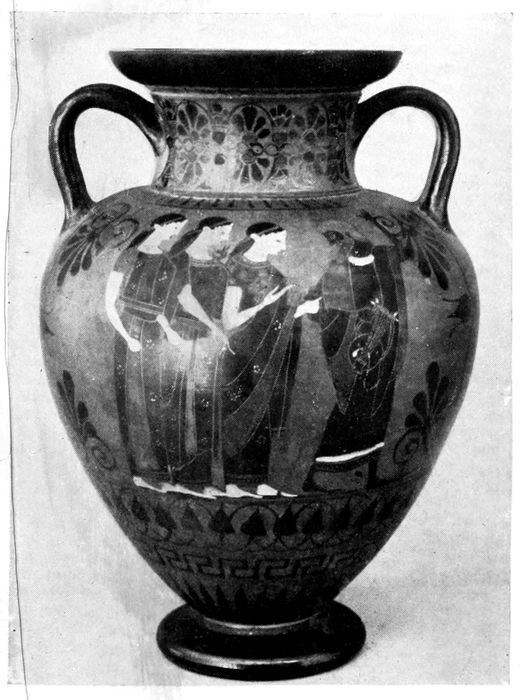
Black-figured type with curving lip and ribbed handles. The decoration extends over the surface of the vase.
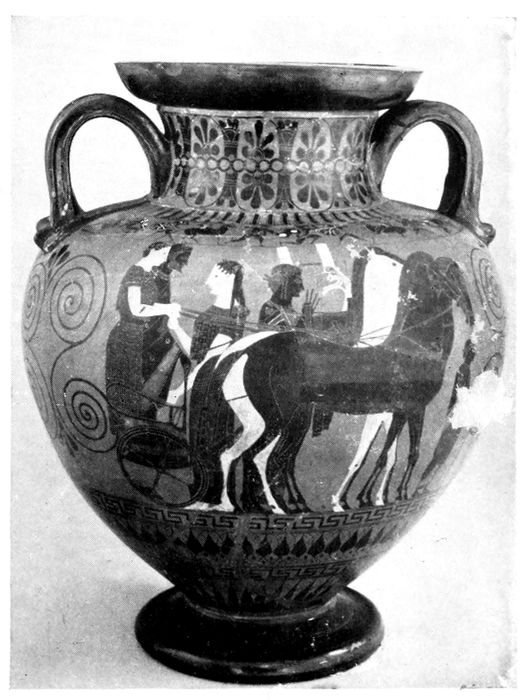
Black-figured amphora of the same general type as the preceding, but broader and heavier.
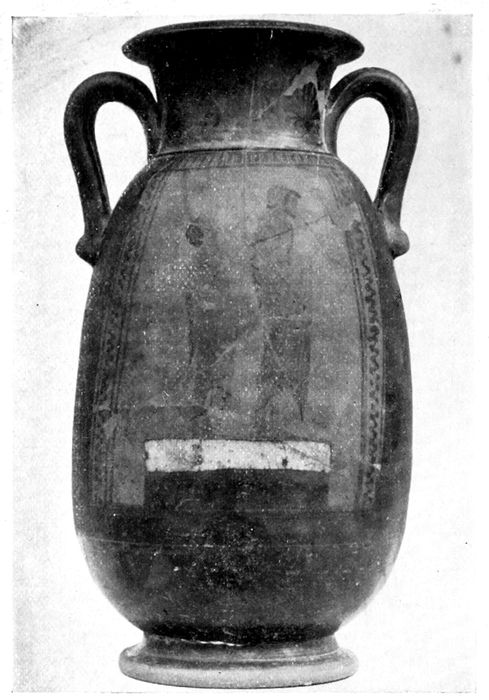
Amphora with short neck and long body. The form of the handles is copied from metal technique.
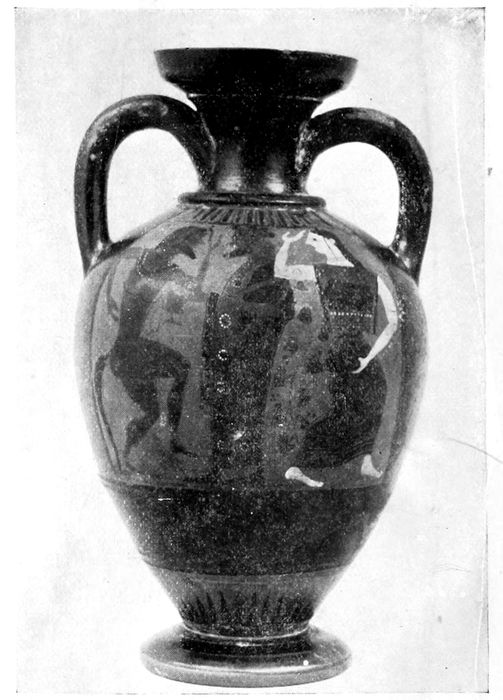
Amphora with high, finely curving handles and black figures on a white body.
In the Museum of Fine Arts, Boston.
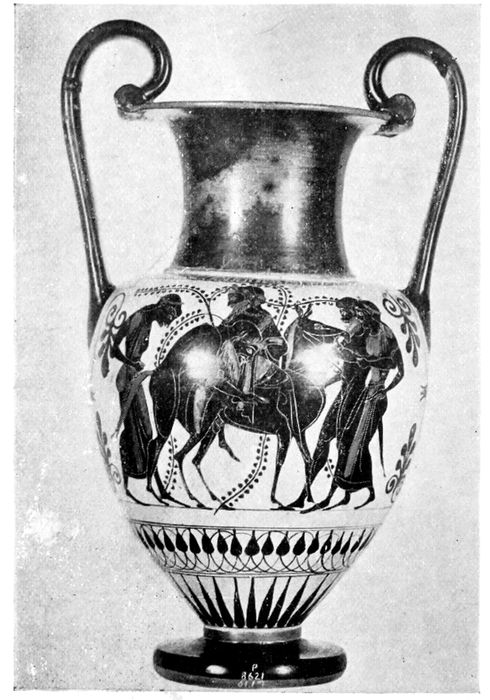
Black-figured amphora; slender neck and egg-shaped body. A rather unusual form. Owned by Albert Gallatin.
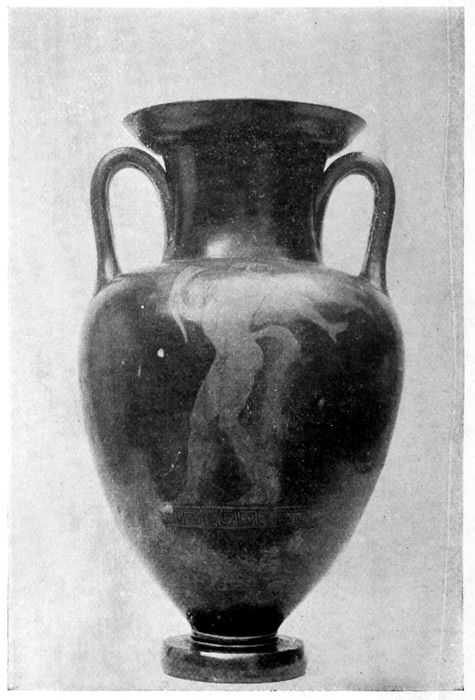
Nolan amphora with elongated neck and egg-shaped body. Form characteristic of the red-figured technique of the early fifth century.
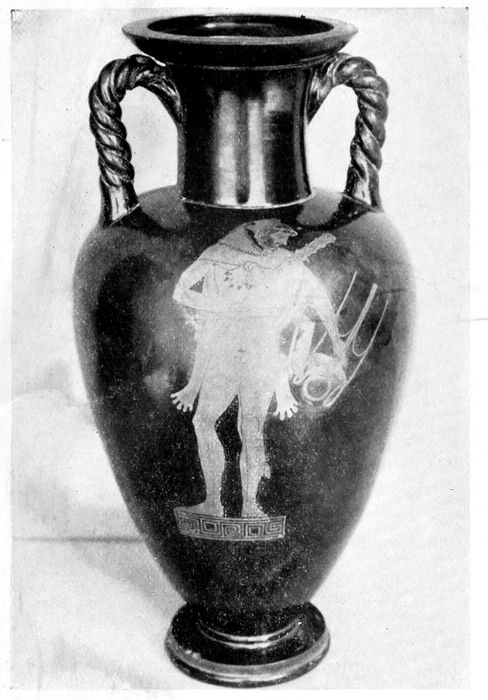
Red-figured amphora with twisted handles, of the first half of the fifth century. There is a decided advance toward slenderness and grace.
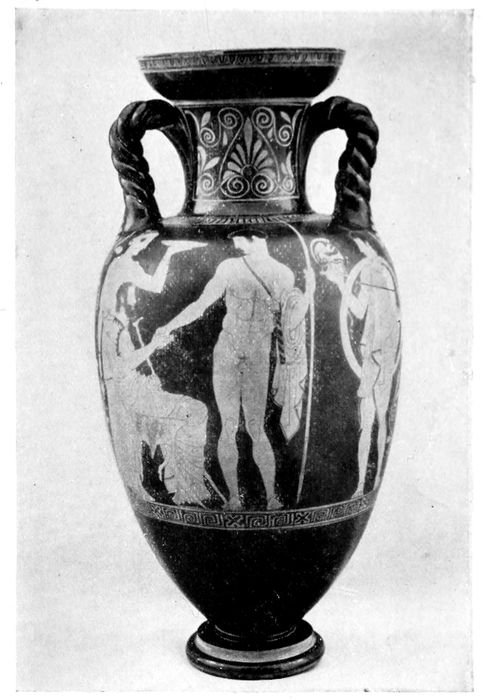
Amphora with narrow neck and pointed body.
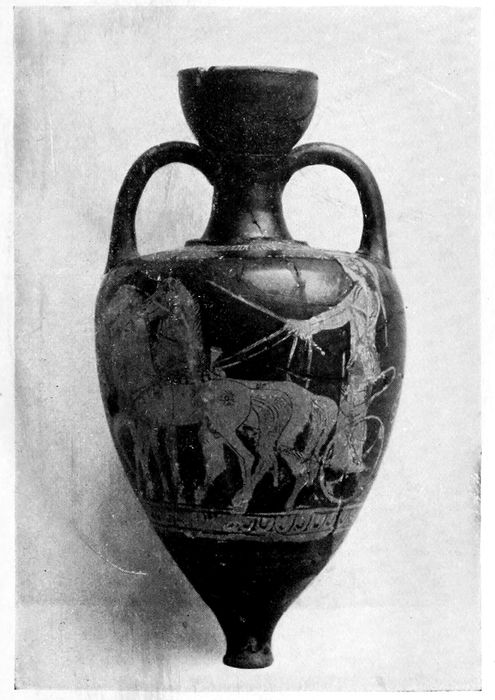
Red-figured amphora with twisted handles, of the second half of the fifth century.
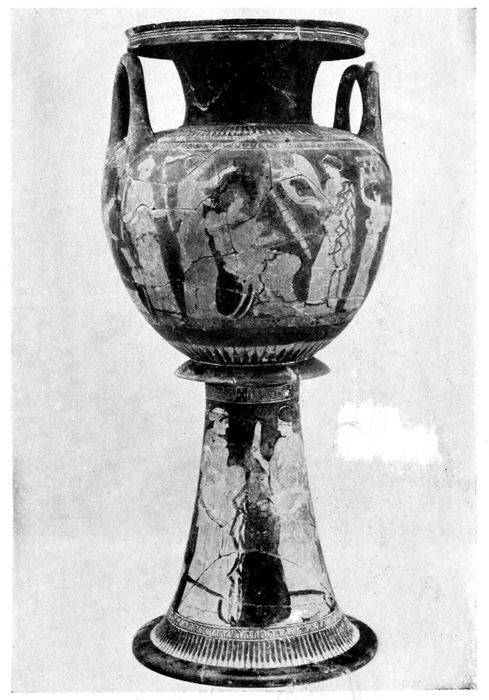
Marriage-lebes with stand, used to hold water for the nuptial bath.
8STAMNOS. A development of the amphora.
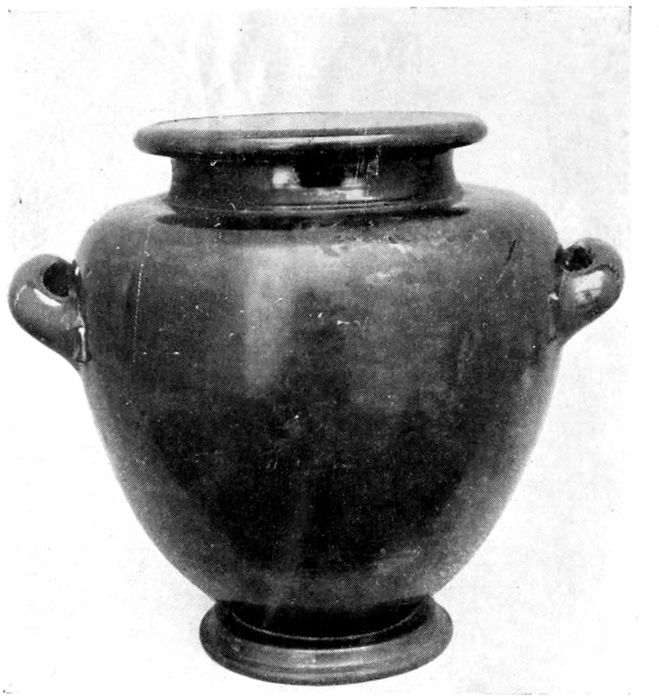
Stamnos. Type characteristic of the early fifth century, with rounded body and short neck.
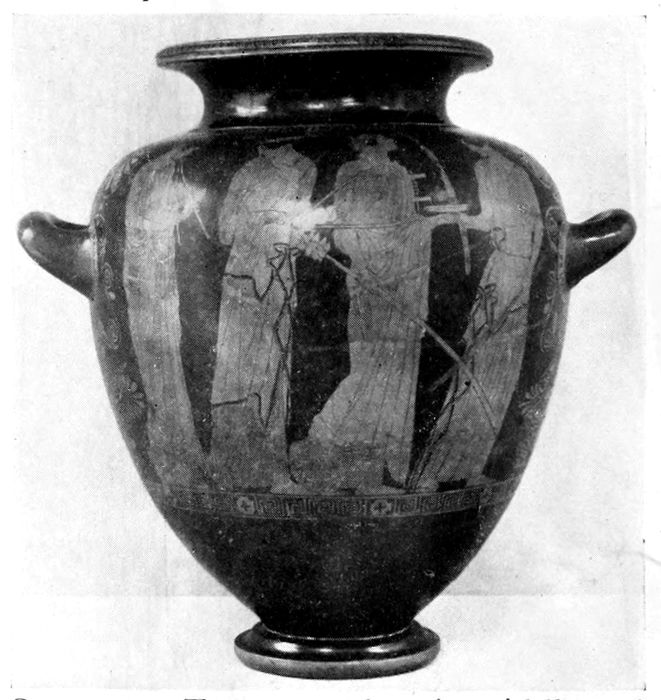
Stamnos. Type prevalent in middle and later fifth century, with more elongated body, smaller foot, and higher neck.
LOUTROPHOROS. Water-jar for the bride’s ceremonial bath.
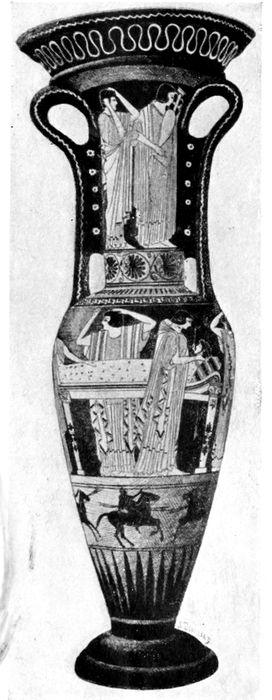
Earlier type with heavy mouth and foot, and handles joined midway to the neck.
In the Louvre, Paris.
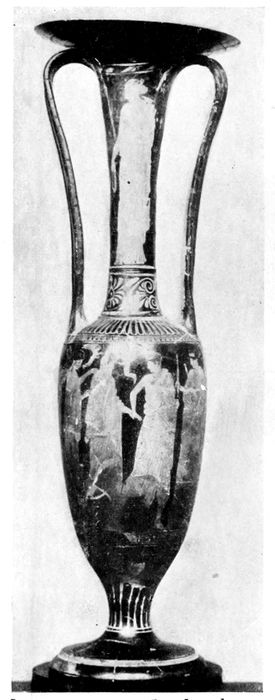
Later type of slenderer proportions, finely curved mouth, foot, and handles.
In the Museum of Fine Arts, Boston.
9KRATER. Vessel for mixing water and wine. It was from the krater that the wine was ladled into the cups.
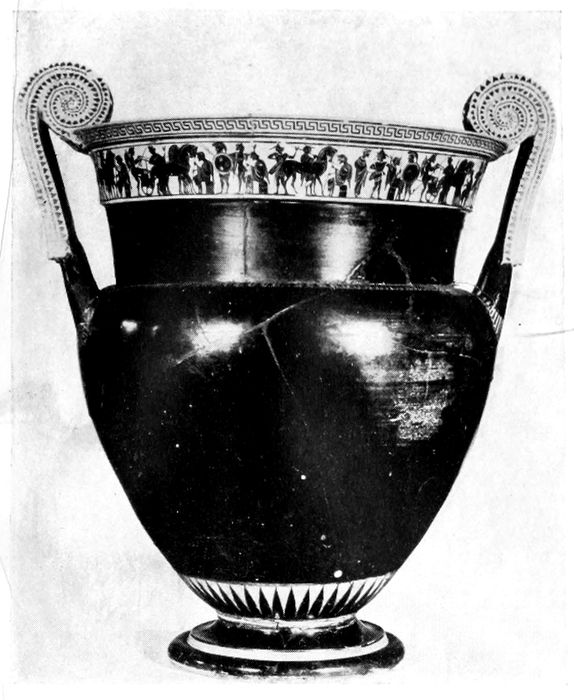
Krater with volute handles decorated in the black-figured technique.
In the Museum of Fine Arts, Boston.
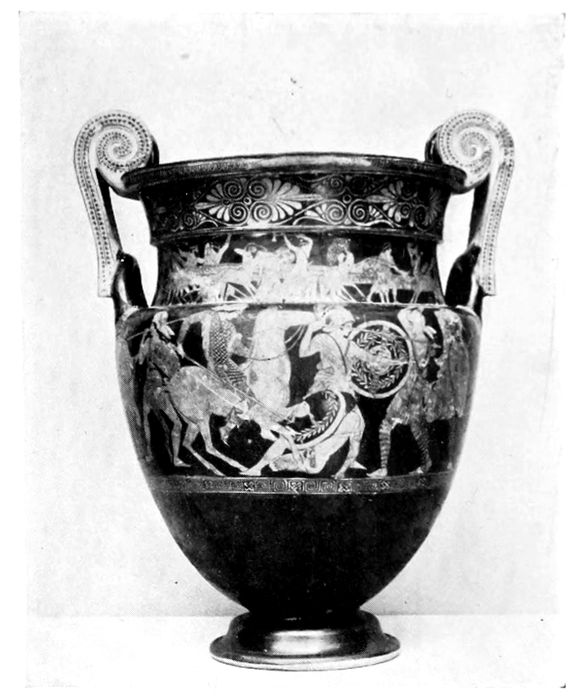
Column krater, so called from the columnar shape of the handles.
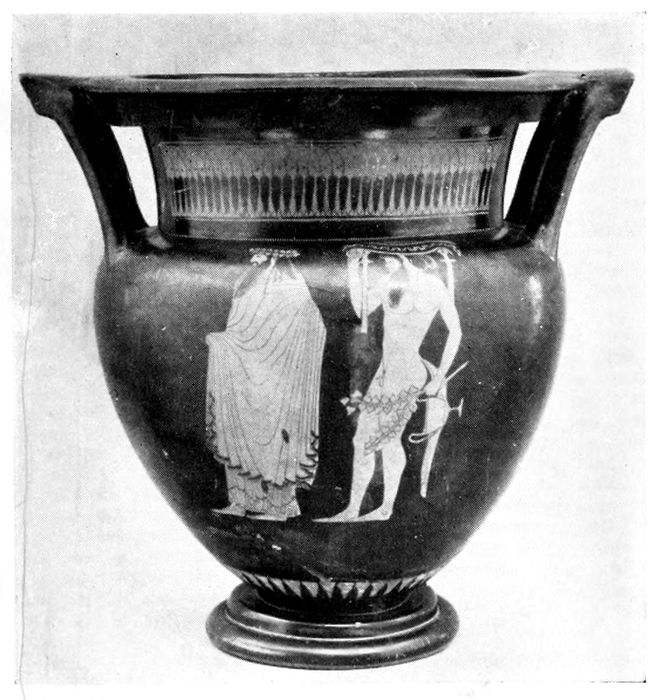
Krater with volute handles in the red-figured technique.
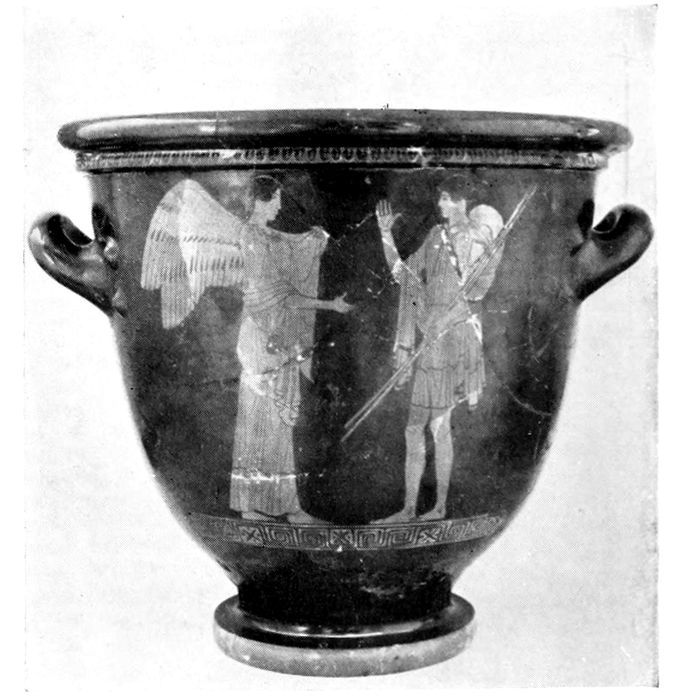
Bell krater, shaped like an inverted bell. This type and the following are characteristic of the red-figured style. Both have handles adapted for carrying the vessel when full.
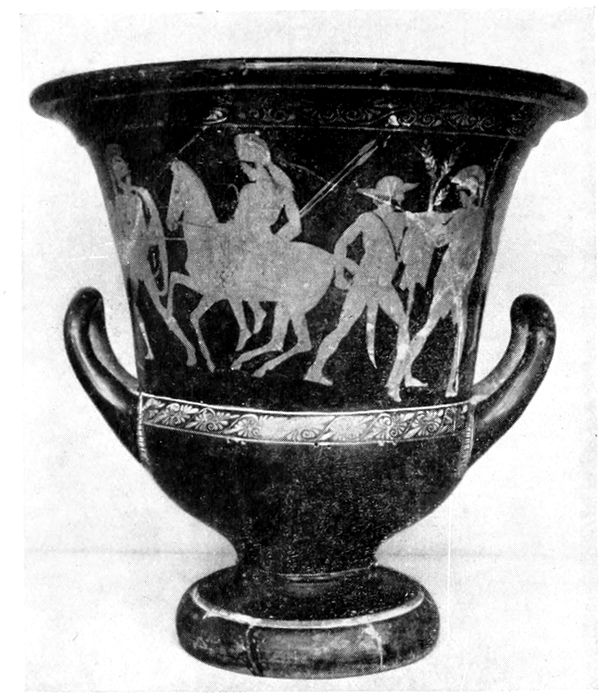
Kalyx krater.
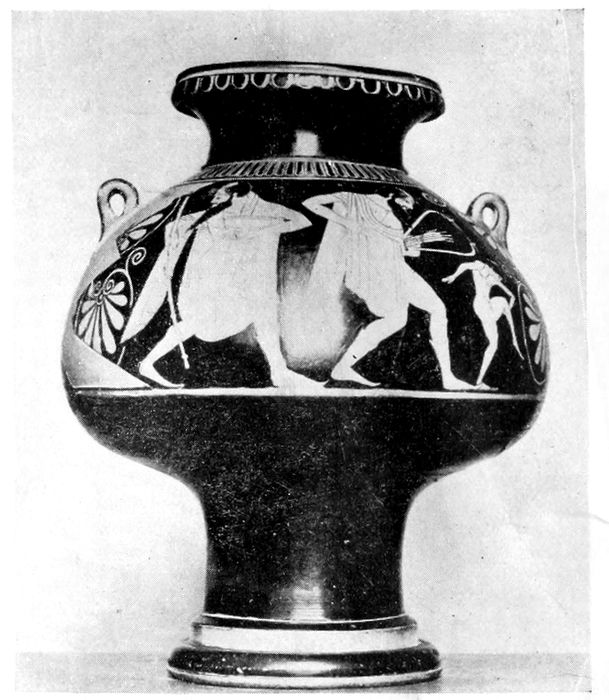
Psykter, vessel for cooling wine. It was placed in another receptacle filled with snow or cold water.
In the British Museum.
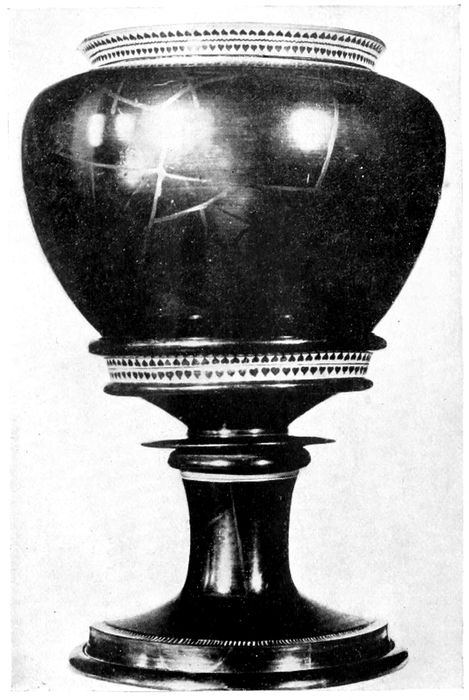
Deinos or lebes, vessel for wine or other liquids, set on a stand. The whole makes a harmonious composition. In the Museum of Fine Arts, Boston.
11HYDRIA. Water-jar having three handles. The handle at the back was used for pouring or for carrying the vessel; the handles at the sides, for lifting.
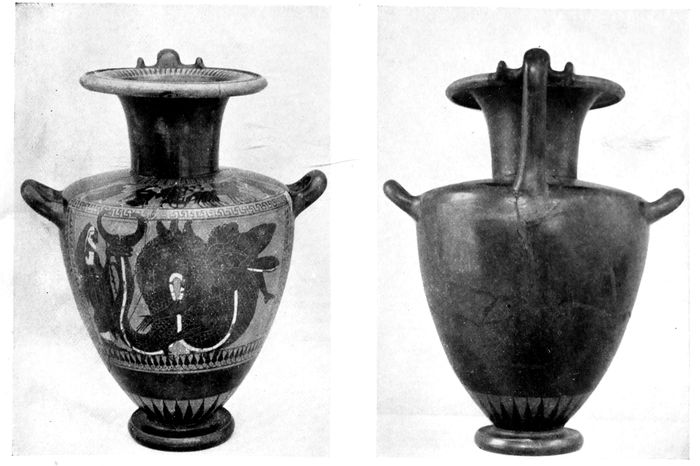
Hydria of the black-figured type having the handle at the back much larger than those at the sides, and the neck at a sharp angle with the body.
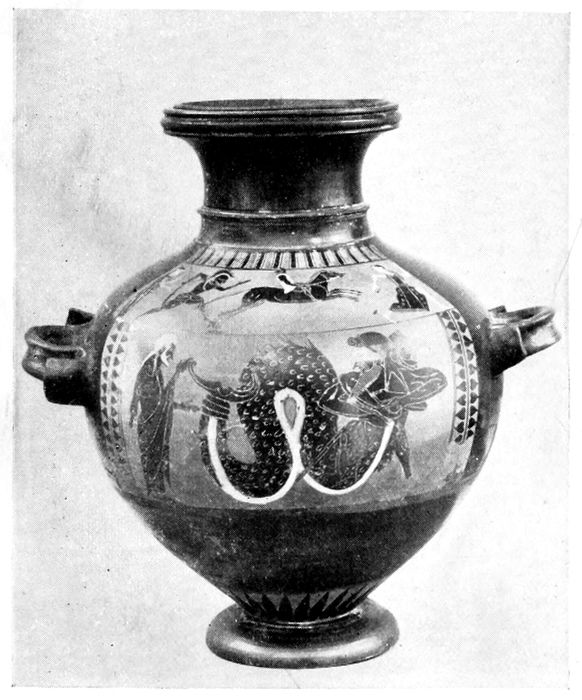
Hydria with rounded body. The handles and mouldings suggest imitation of metal technique.
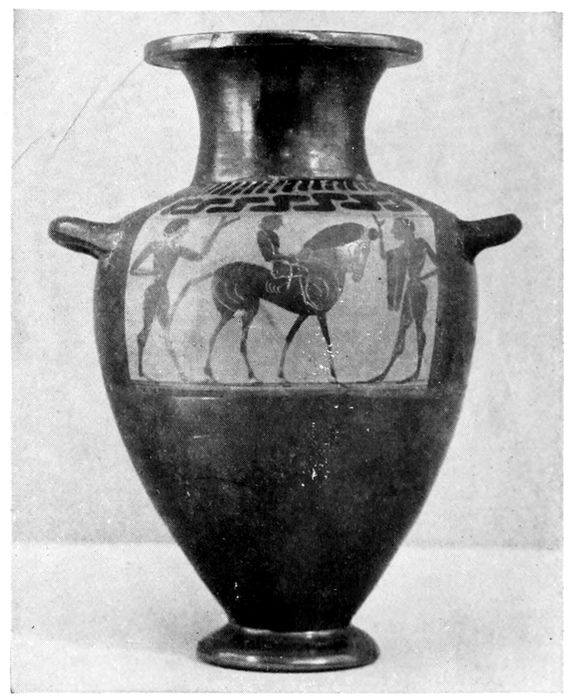
Hydria with more strongly curving shoulder and conical foot.

Black-figured hydria with continuous curve for neck and body, broad foot, and handles placed rather low.
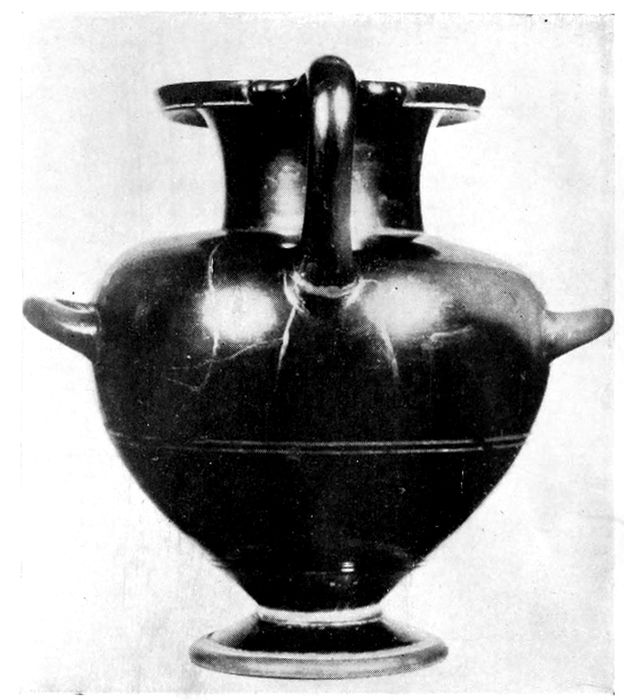
Black-figured hydria with neck distinctly marked and shoulder and body forming a continuous curve.
In the Museum of Fine Arts, Boston.
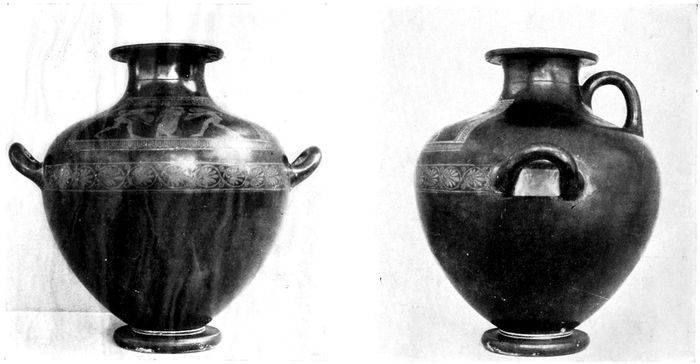
Hydria of red-figured type showing the acme of development of this shape.
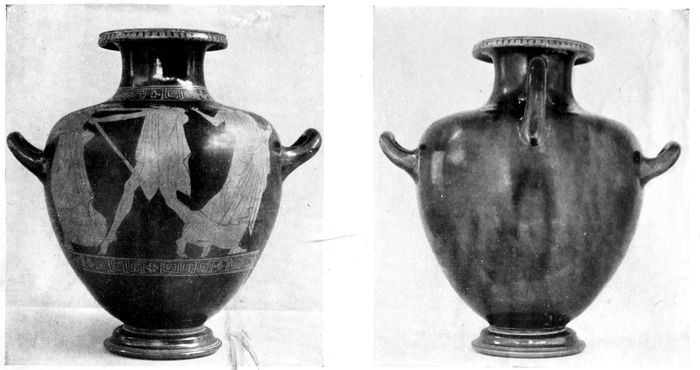
Hydria of the second half of the fifth century, slightly slenderer than the preceding, with finely curving foot.
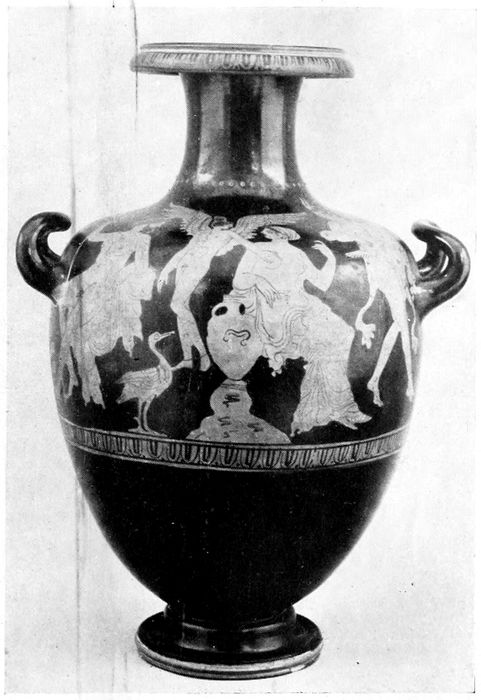
Hydria of the late red-figured type with egg-shaped body, broad lip, and side handles curving upward. Note the deterioration in the curve of the foot.
14OINOCHOË. Wine-jug.
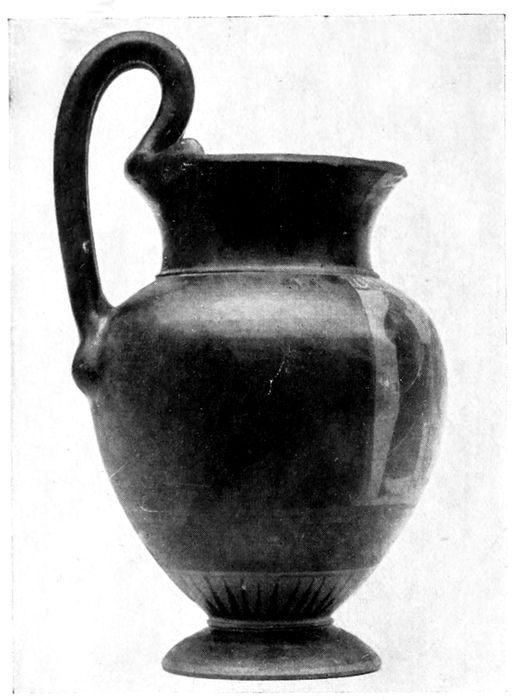
Oinochoë with round mouth and high handle, having the neck distinct from the body.
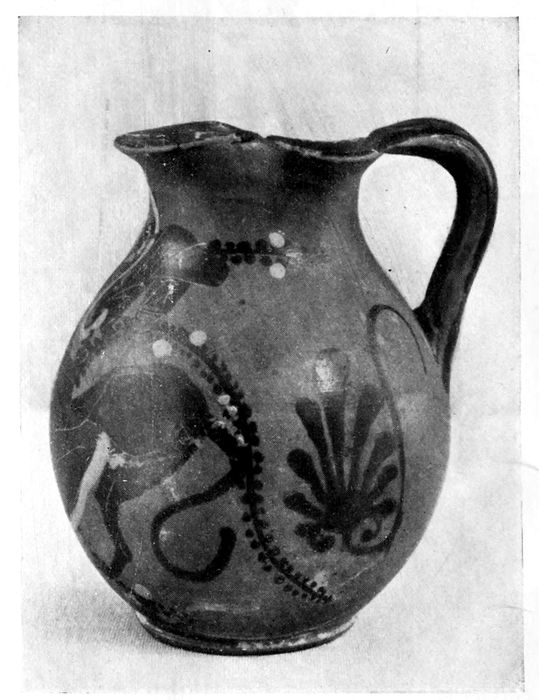
Oinochoë with trefoil lip, short handle, and continuous curve for neck and body.
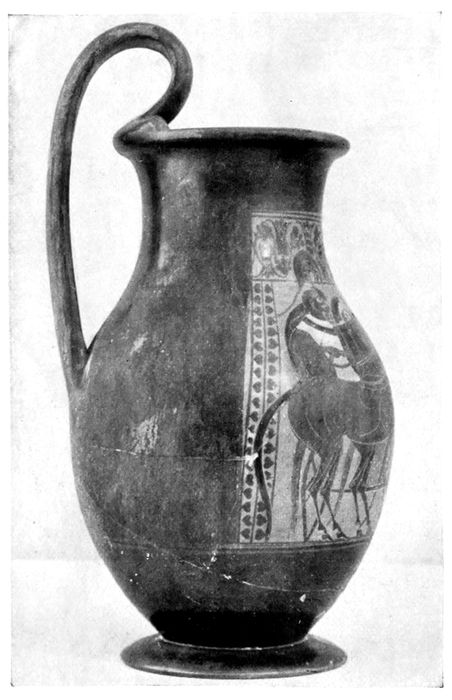
Oinochoë with round mouth and high handle. The neck and body form a continuous curve.
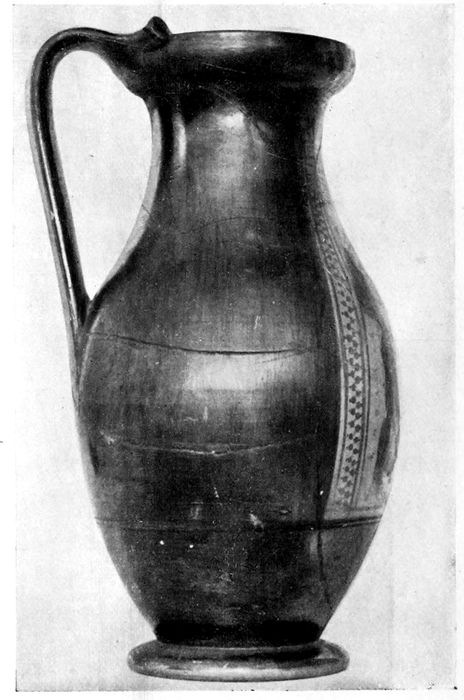
“Olpe,” oinochoë with round mouth and continuous curve for neck and body.

Oinochoë with high handle, trefoil lip, and egg-shaped body, a particularly graceful form.
In a private collection, New York.
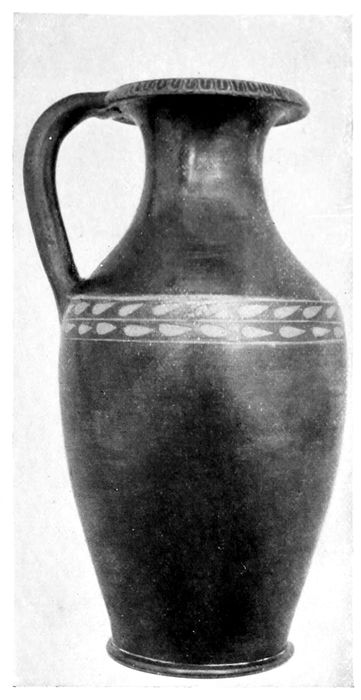
“Olpe,” oinochoë with round mouth and low foot.
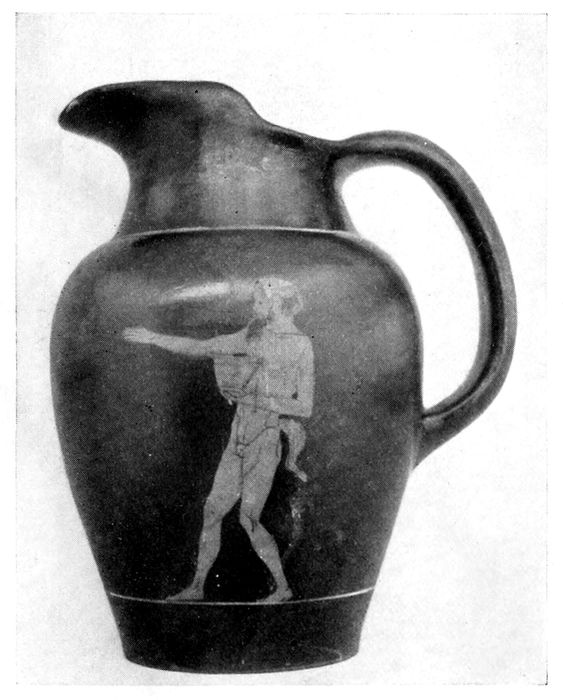
Oinochoë with central lobe of trefoil mouth accentuated, and no foot.
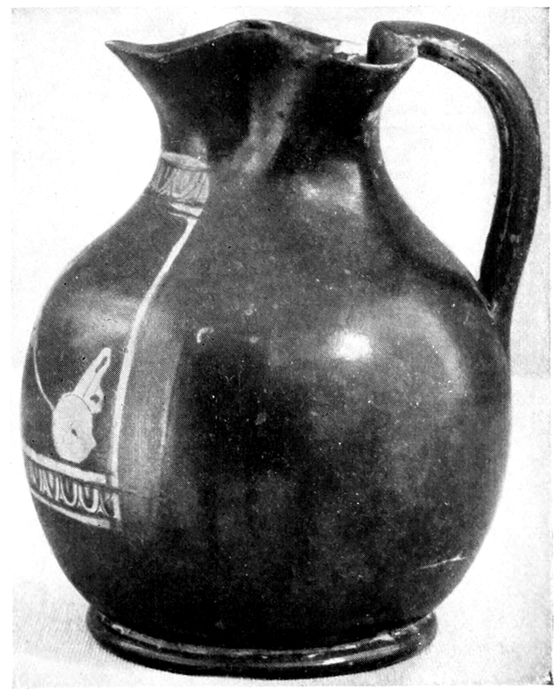
Oinochoë of the second half of the fifth century; squat body, delicately curved trefoil lip.
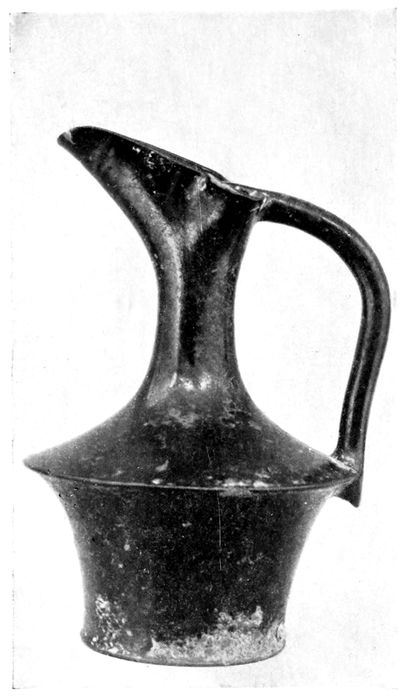
Oinochoë with sharp division between shoulder and body.
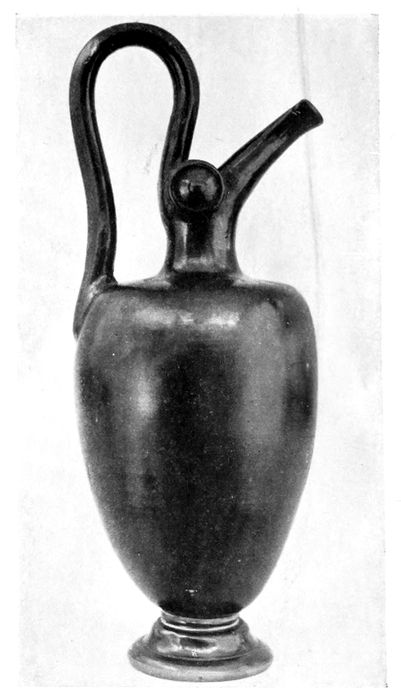
Oinochoë with finely shaped mouth and broad body.
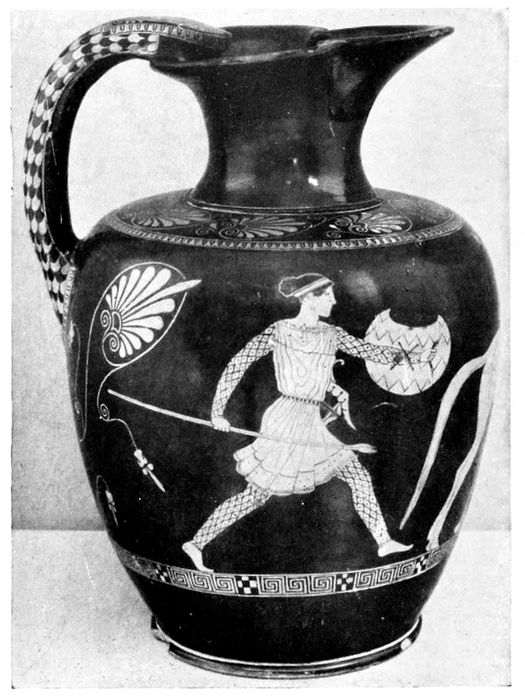
Oinochoë with beaked spout and disk at the side, a variation of the usual trefoil mouth.
17DRINKING CUPS—KYLIX. The kylix with two handles and high foot was the favorite cup shape of the Athenian potters. The difficulty of decorating the strongly curving surface of the body invited the best efforts of contemporary vase painters.
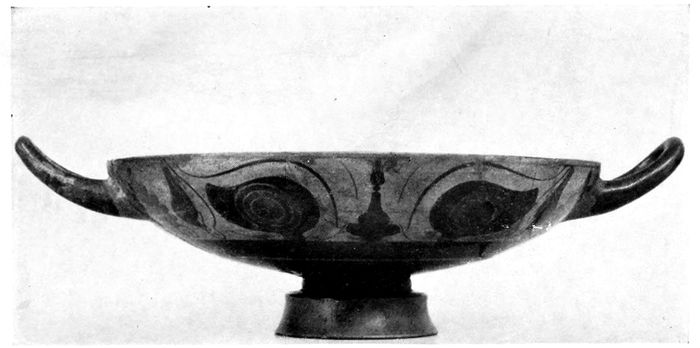
Kylix of “Ionic” form with short foot of rectangular profile connected with the body by a moulding.

Black-figured kylix with low foot. The deep bowl has no separate lip.
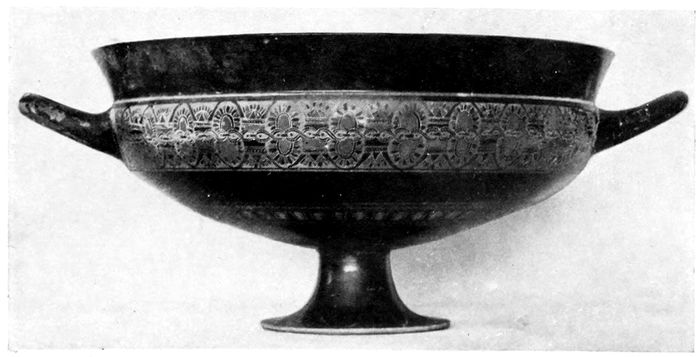
Black-figured kylix with deep bowl, offset lip, and low foot.

Black-figured kylix with offset lip and high foot.
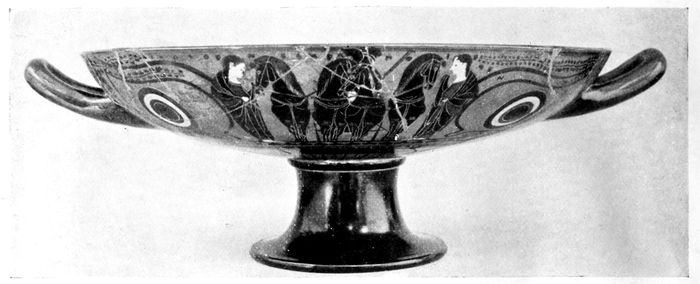
Black-figured kylix with graceful bowl and heavy foot.
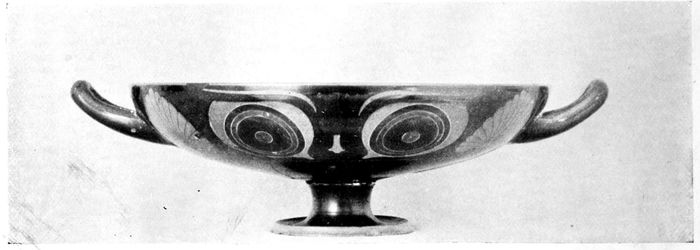
Kylix of form intermediate between the black-figured and red-figured types.
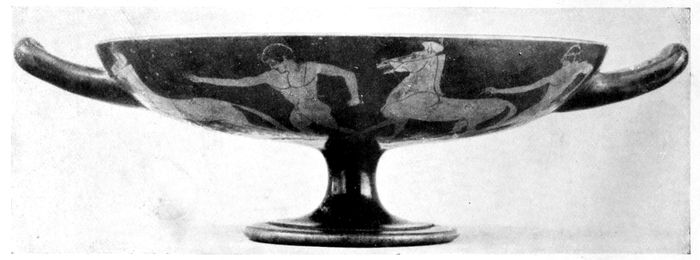
Kylix of red-figured type with flat bowl, slender high foot, and horizontal handles curving upward at the ends. The proportion of the bowl, foot, and handle to one another is more harmonious than in the preceding example.
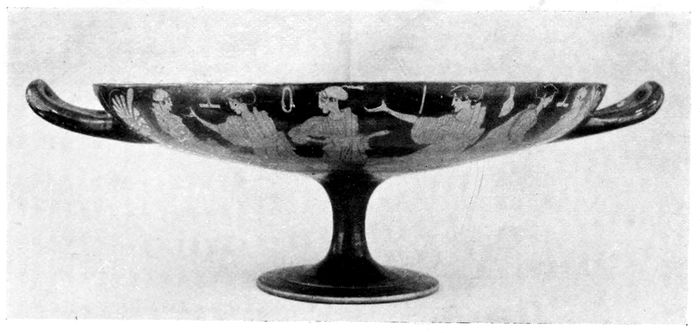
Kylix in use during the best period, showing the highest development of this shape. The beauty of the unbroken curve between the edge of the lip and the bottom of the foot is the result of a century of continued study.
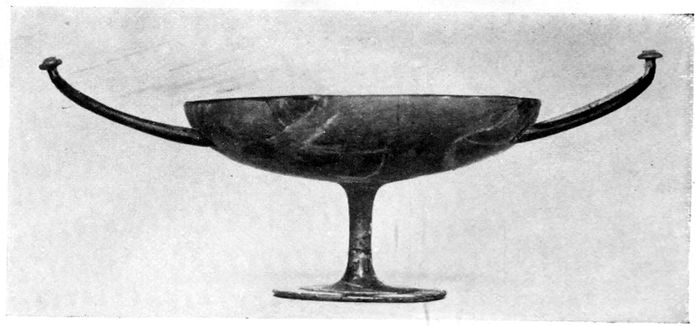
Kylix with “wishbone” handles, a very graceful, slender form in use in the later fifth century.
In the British Museum.
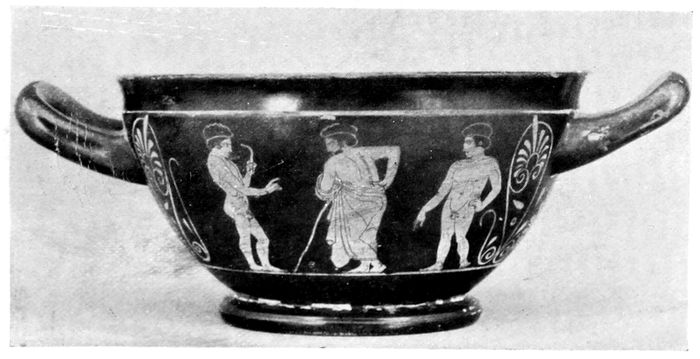
Red-figured kylix with deep bowl, offset lip, and flat foot. A shape intermediate between the kylix and the skyphos.
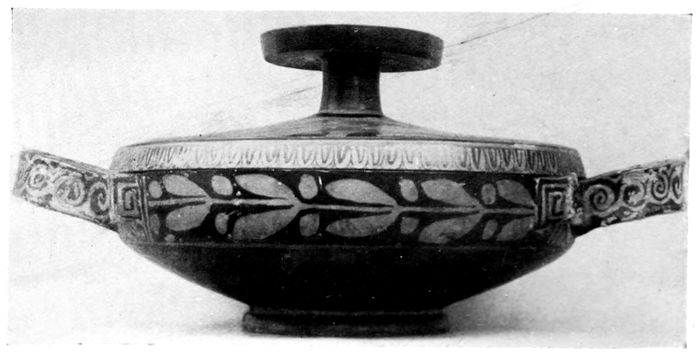
Lekane, covered dish of uncertain use. It often appears in vase paintings of toilet scenes.
22DRINKING CUPS—KANTHAROS.
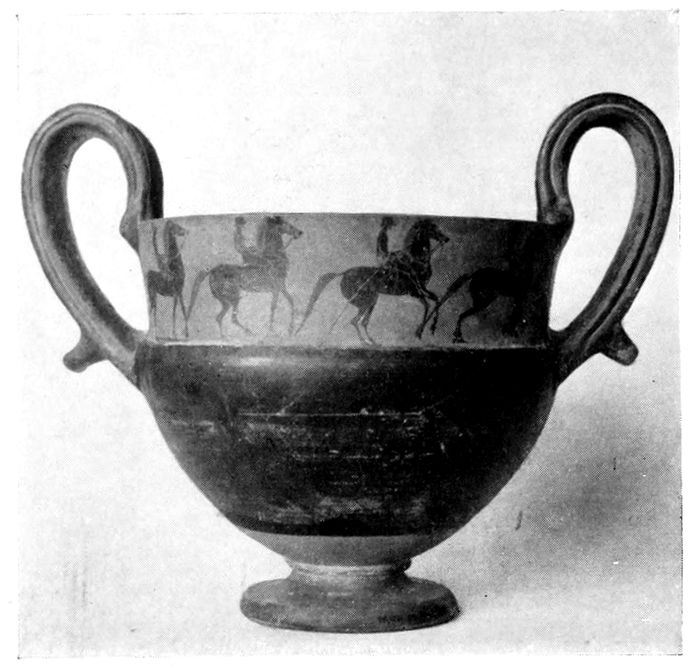
Kantharos of black-figured type with offset lip and high curving handles.
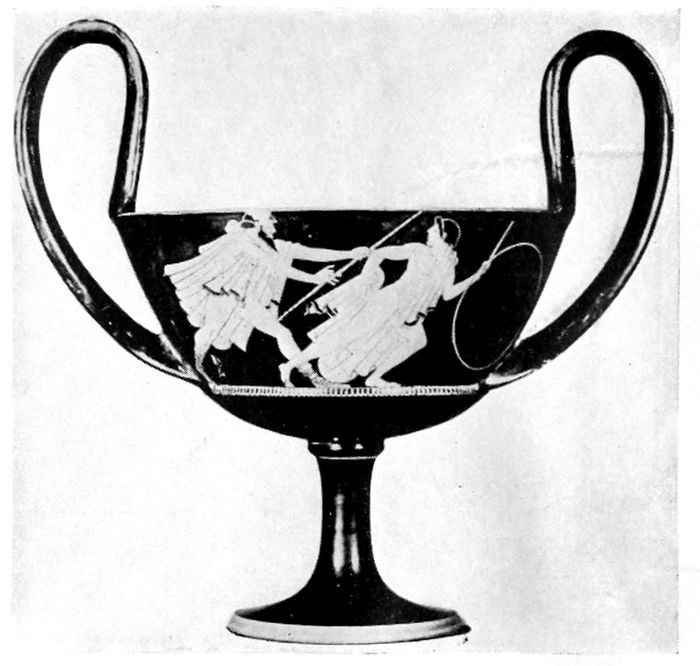
Kantharos with high foot, tall handles, and both bowl and lip forming a continuous curve. Perhaps one of the most beautiful shapes designed by the Athenian potters.
In the Museum of Fine Arts, Boston.
DRINKING CUPS—SKYPHOS.
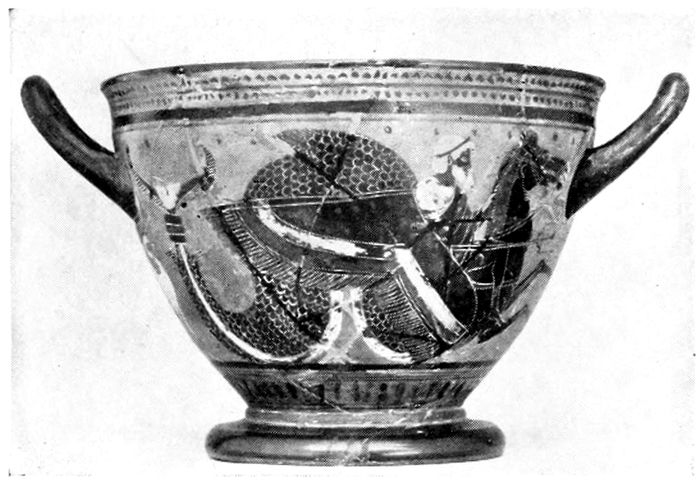
“Skyphos,” a deep drinking cup with a flat foot and strongly curving handle.
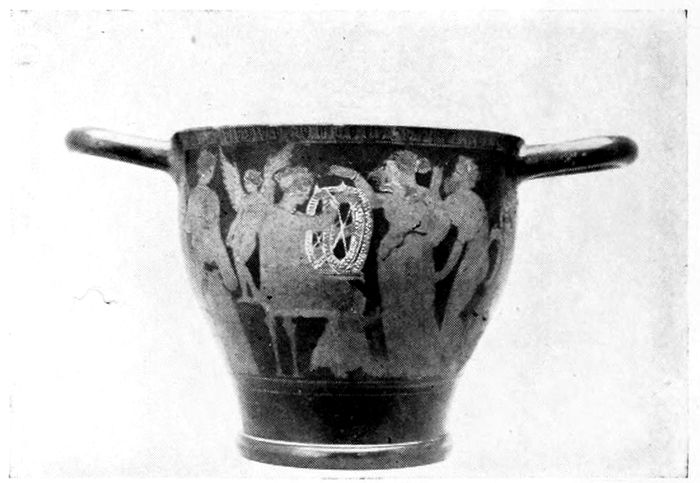
“Skyphos” or “Kotyle,” a deep drinking cup with flat foot and small horizontal handles.
23DRINKING CUPS—OTHER FORMS.
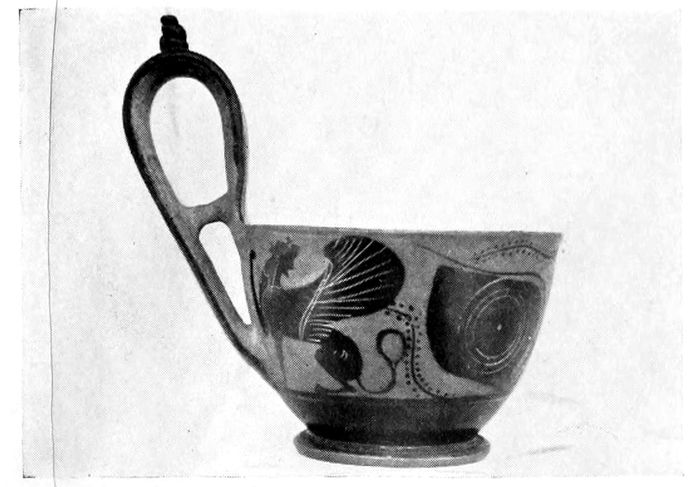
Kyathos, ladle used for dipping wine from the krater into the drinking cups.
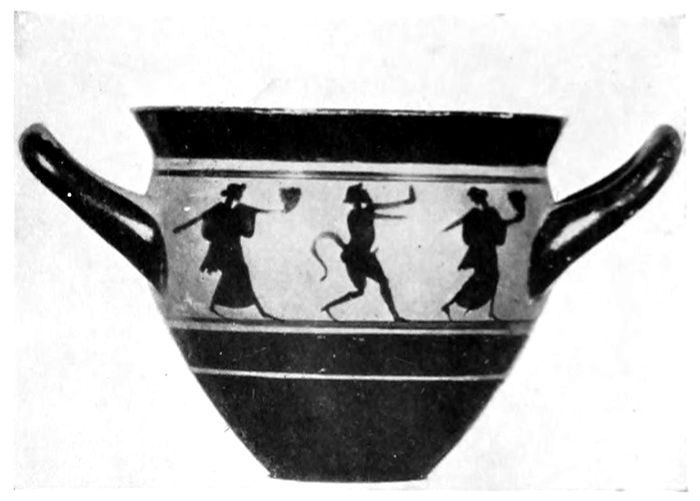
Small cup with offset lip, two handles, and no foot.
In the Museum of Fine Arts, Boston.
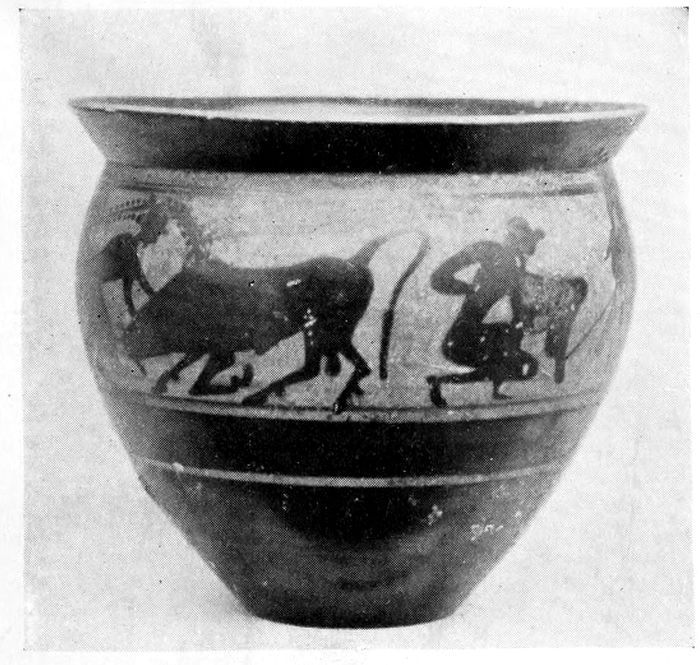
Small cup without handles.
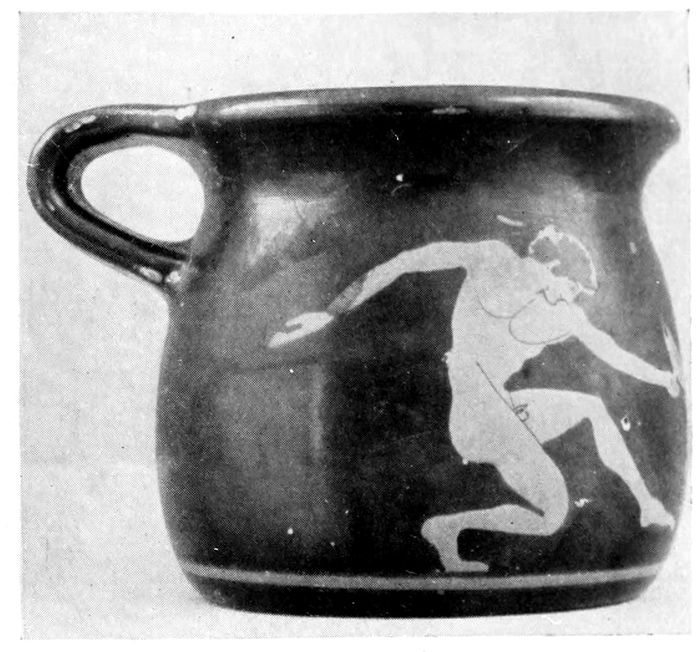
One-handled cup with offset lip and no foot.
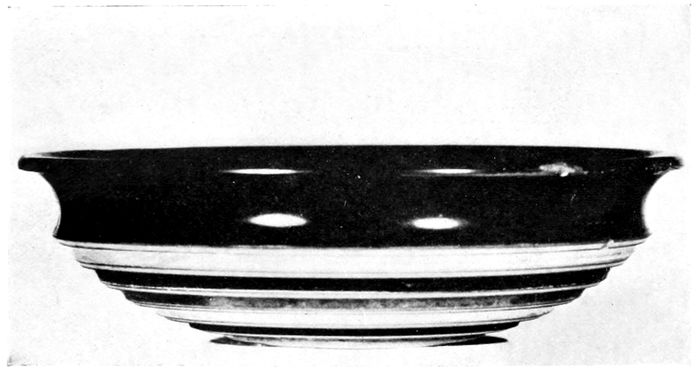
Phiale, shallow bowl with a central boss. This shape was used especially for libations.
In the Museum of Fine Arts, Boston.
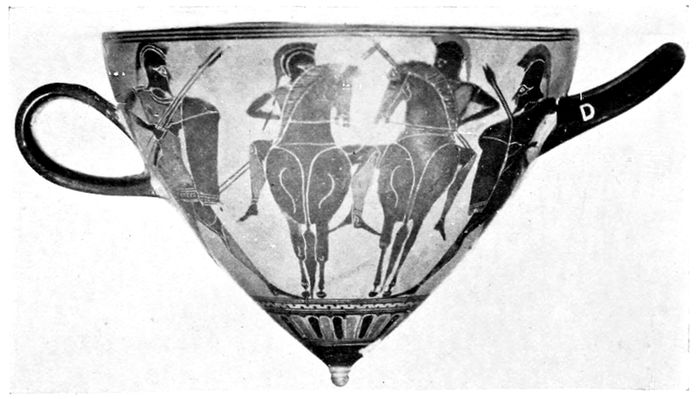
Mastos, so called because the shape resembles a woman’s breast.
In the British Museum.
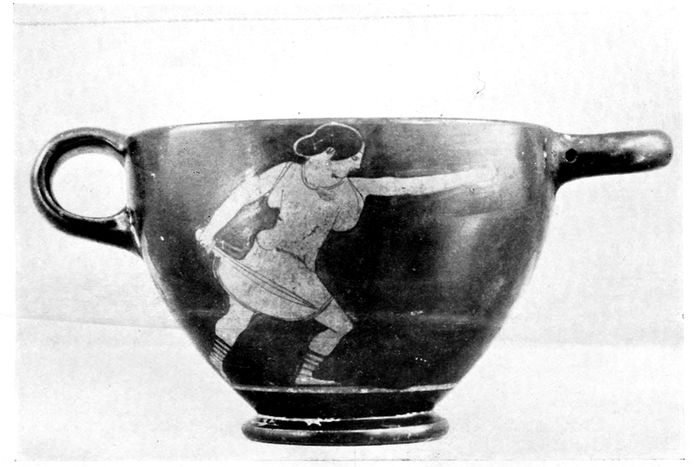
Cup with two handles, one horizontal and the other vertical.
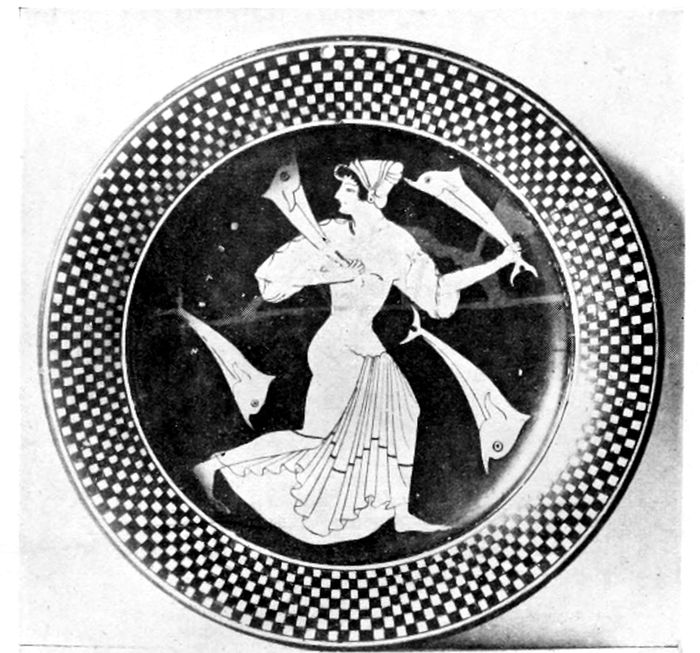
Pinax, a flat plate. Note how well the decoration is adapted to the space.
In the Museum of Fine Arts, Boston.
26MOULDED VASES. The bodies of these vases were made in moulds in the form of human and animal heads while the mouths were shaped on the wheel. Such moulds, however, were not used for producing hundreds of identical vases, as nowadays.
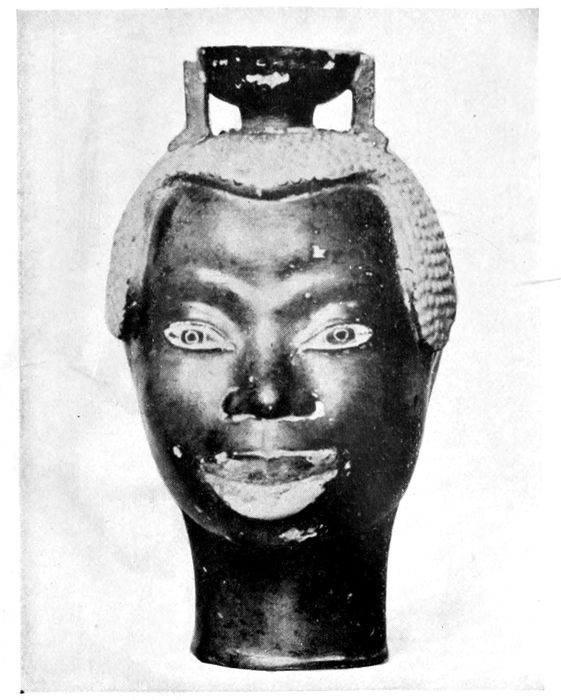
Aryballos in the shape of a negro’s head.
In the Museum of Fine Arts, Boston.
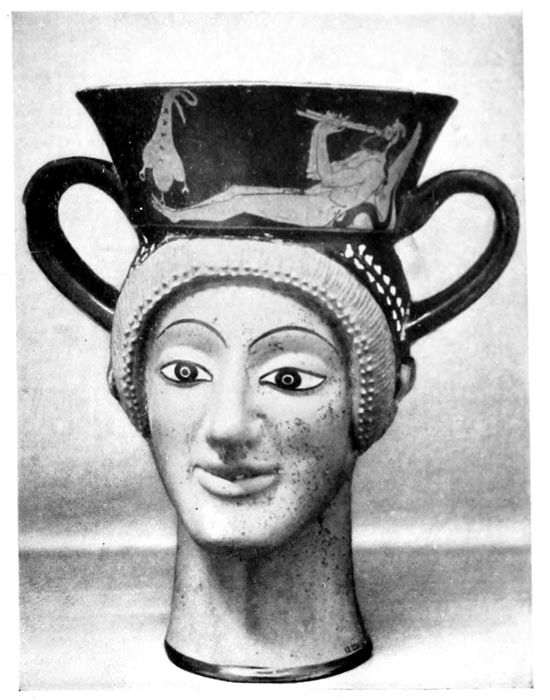
Cup in the form of two female heads, back to back.
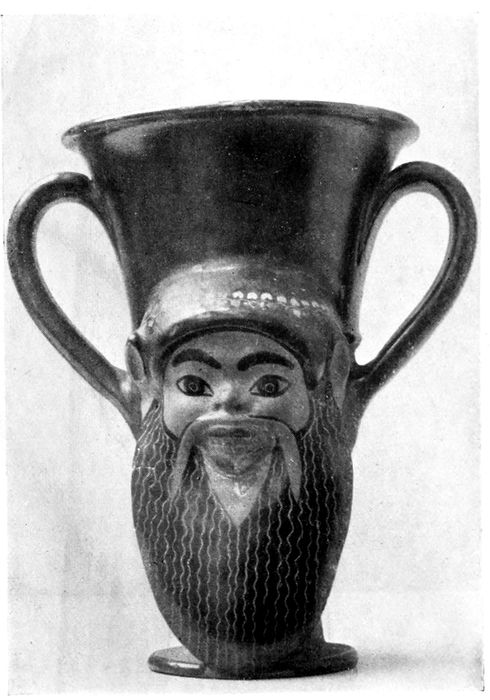
Cup in the form of a Seilenos head.
Owned by Albert Gallatin, New York.
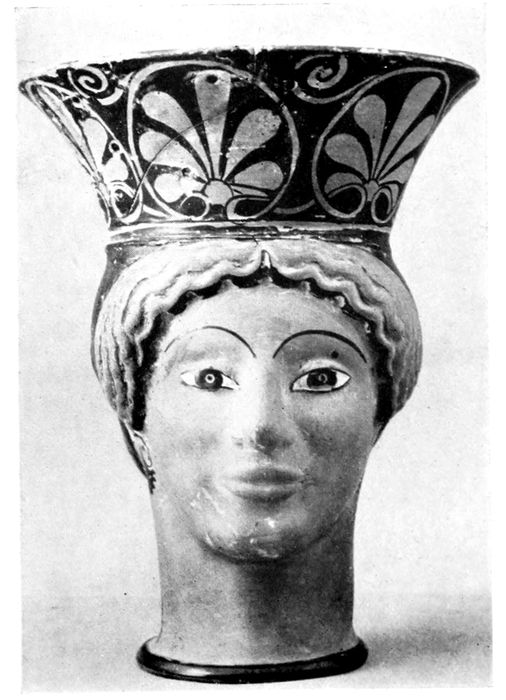
Cup without handles in the form of a woman’s head.

Cup in the form of a cow’s head.
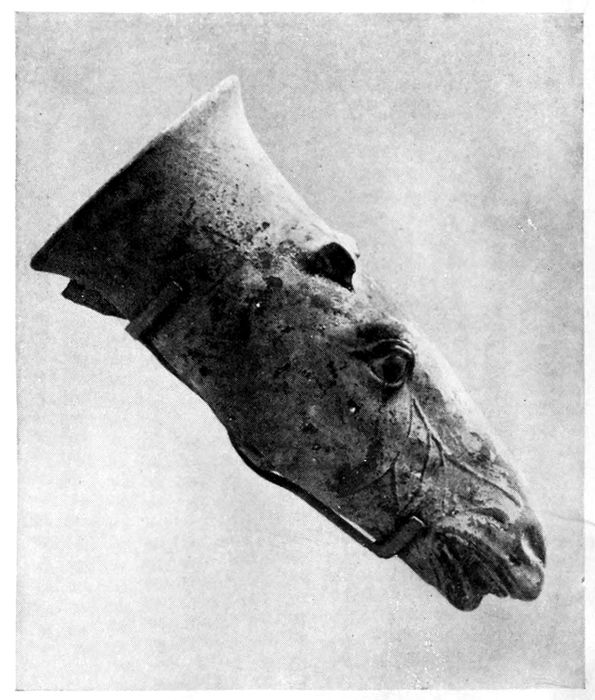
Cup in the form of a horse’s head.
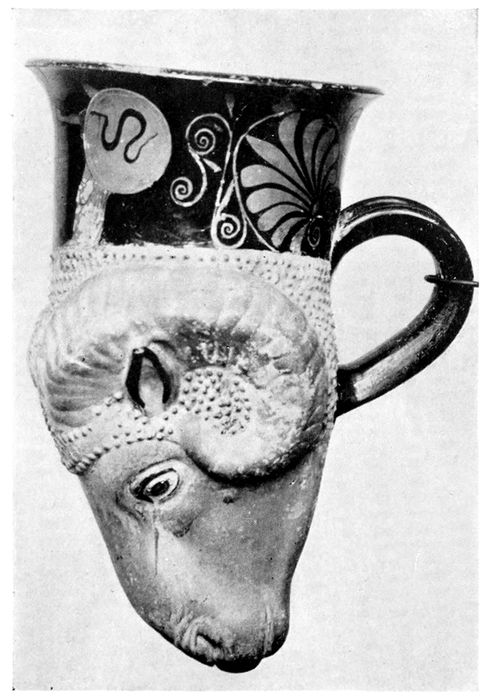
Cup in the form of a ram’s head.
In the Museum of Fine Arts, Boston.
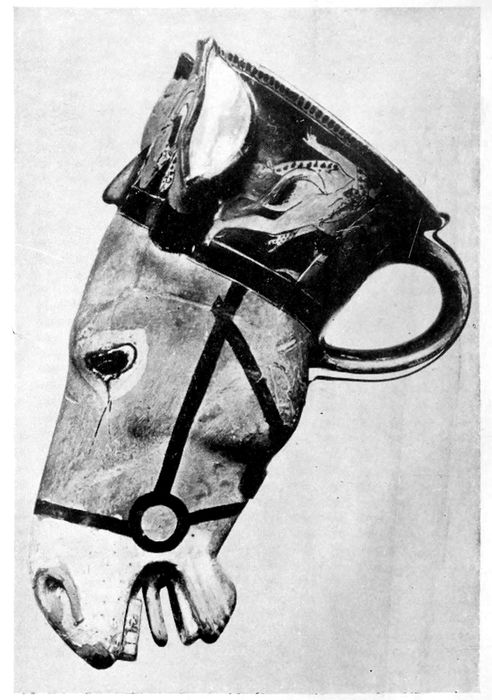
Cup in the form of a mule’s head.
In the Museum of Fine Arts, Boston.
28LEKYTHOS. Oil-jug. The narrow neck and deep mouth were designed to make the liquid flow out slowly.
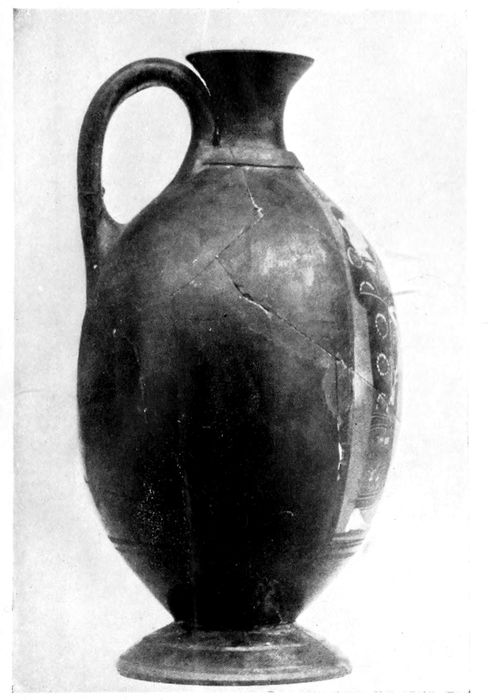
Early black-figured example with egg-shaped body and no distinct shoulder.

Later black-figured type with high neck and shoulder distinct from the body.
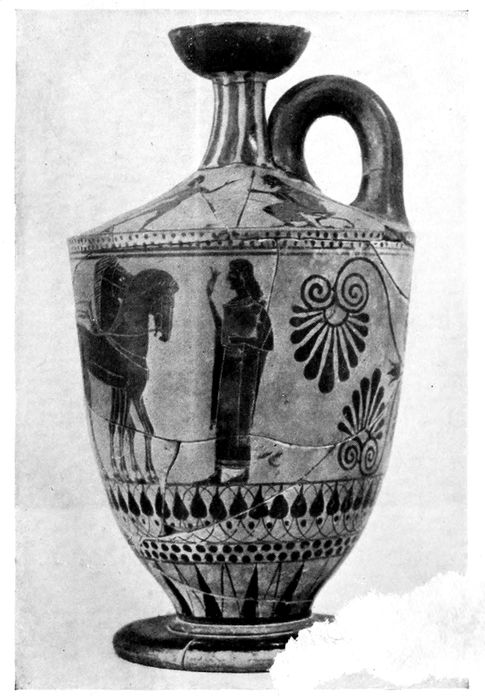
Black-figured lekythos with broad shoulder distinct from the body.
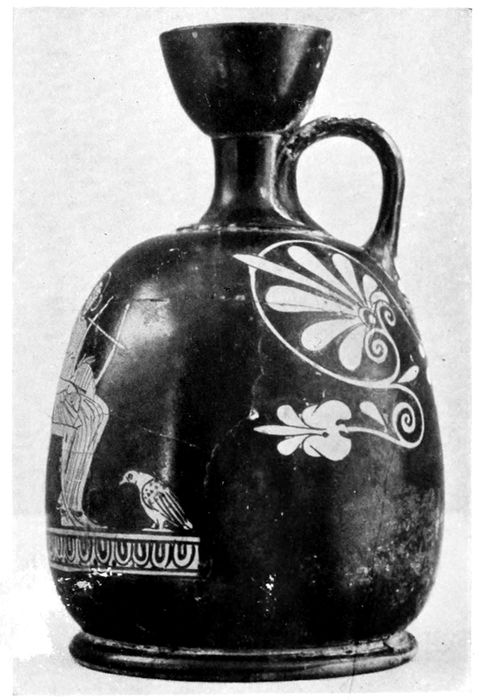
Early red-figured type of squat shape with large flat foot.
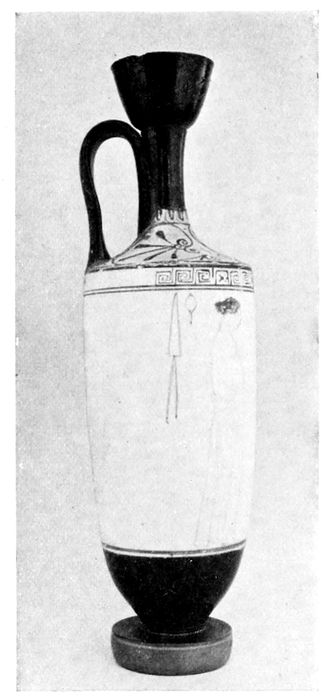
Lekythos of the finest type with slender body and high neck and handle.

Lekythos of the later fifth century, of exaggerated slenderness.
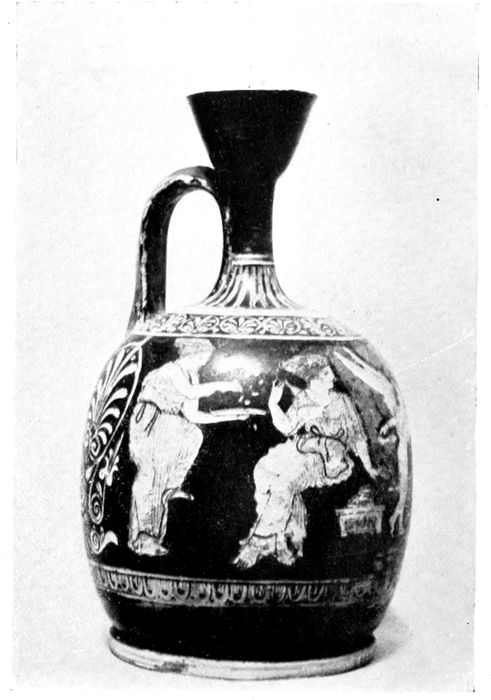
Squat lekythos with broad flat foot, a shape popular among the later Athenian potters.
30TOILET JARS.
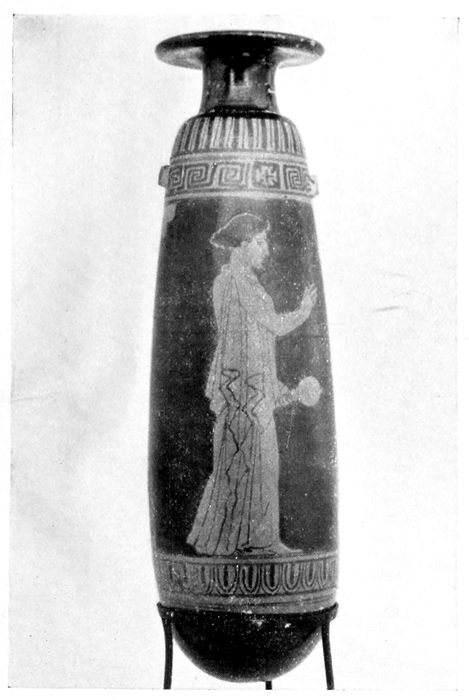
Alabastron, for holding oil or perfumes.
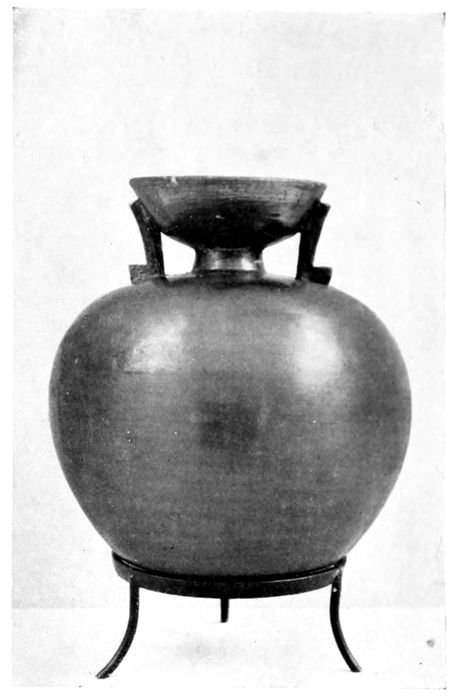
Aryballos, oil-jug. Vases of this shape are often seen suspended from the wrists of athletes.
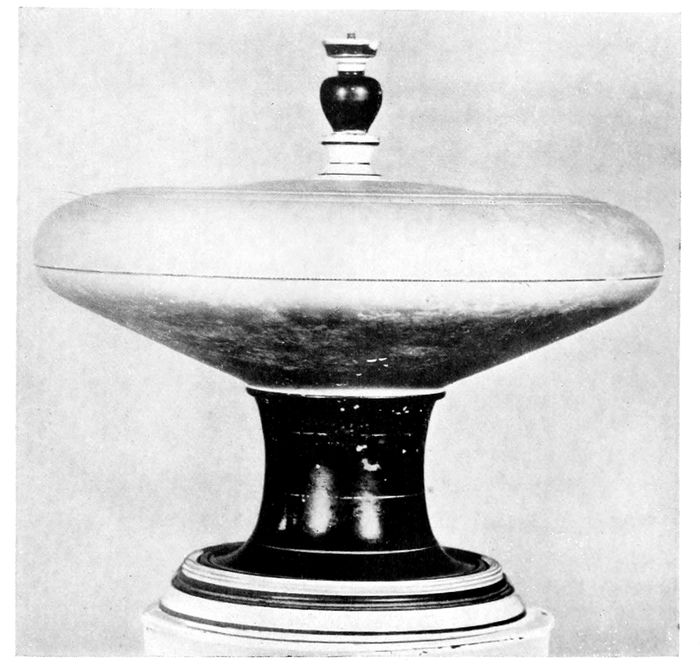
Vase (the ancient plemochoë?), probably used for holding perfumes, a shape intermediate between the pyxis and the lekane. Note the delicately executed knob serving as handle to the lid. In the Museum of Fine Arts, Boston.
31TOILET JARS—PYXIS. Small terracotta box for holding toilet articles. It regularly has a cover provided with a knob or a bronze ring for handle.
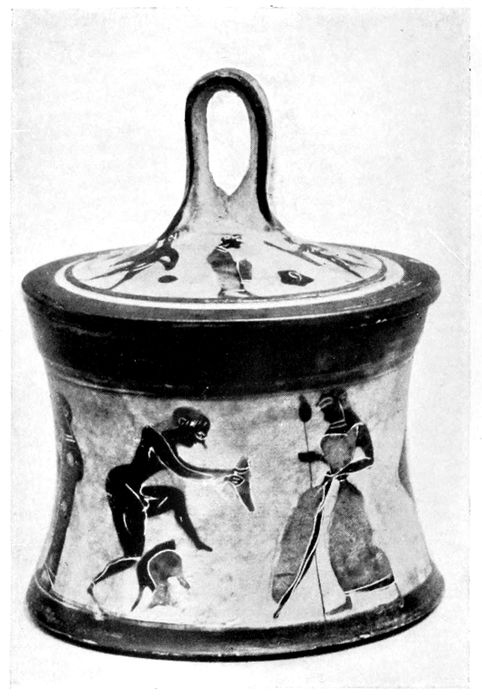
Black-figured pyxis with a loop handle on the cover.
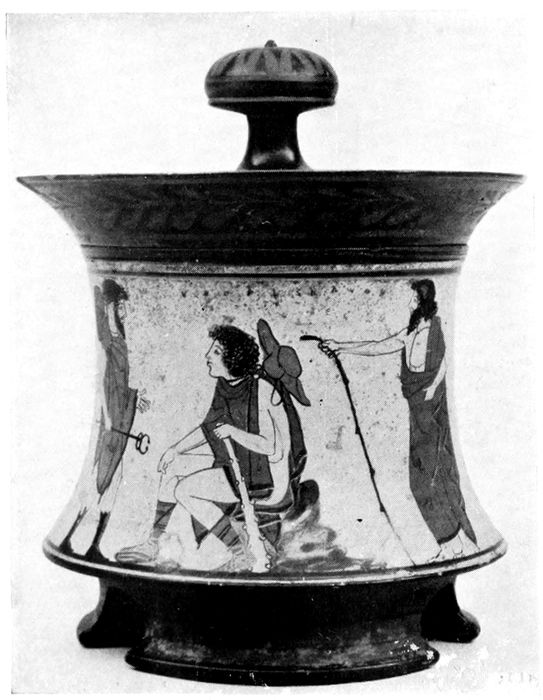
White pyxis of conspicuously beautiful design and execution, decorated with figures in color on a white ground. In the foot are three notches for easier handling.
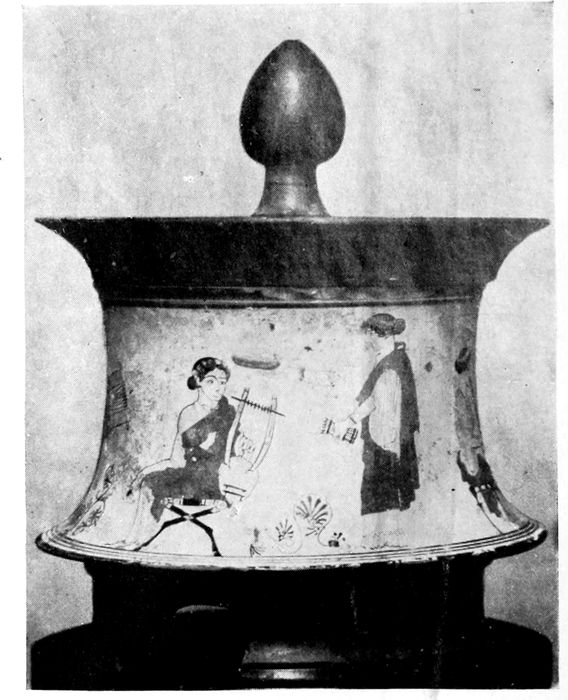
White pyxis of design similar to the preceding, but with elongated instead of arched knob. It also is an exceptionally fine product of the potter’s art.
In the Museum of Fine Arts, Boston.
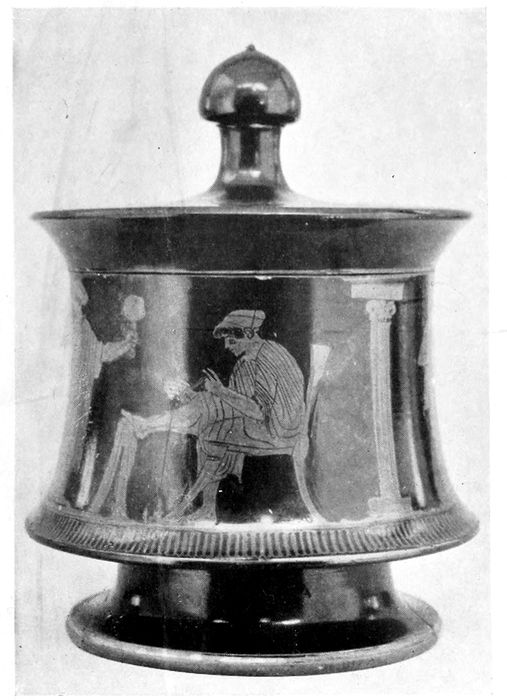
Red-figured pyxis with high foot and knob-shaped handle.
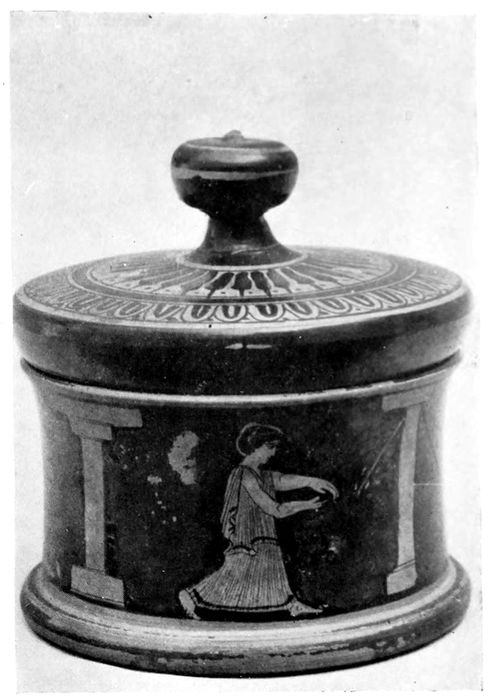
Red-figured pyxis with cylindrical body and low, broad foot.
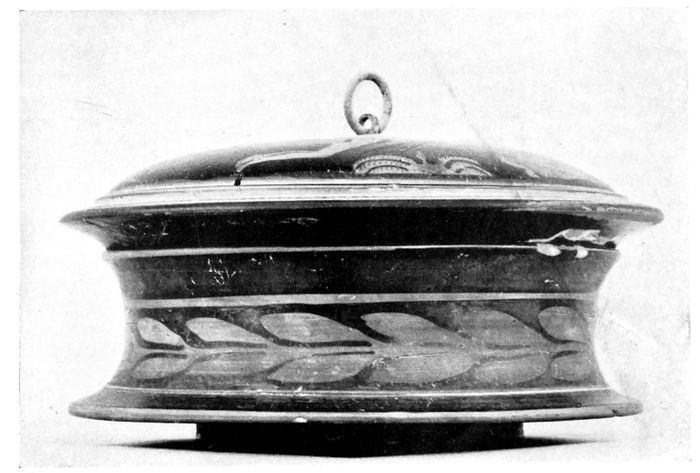
Red-figured pyxis of the late fifth century with low, broad body and a bronze ring on the cover.
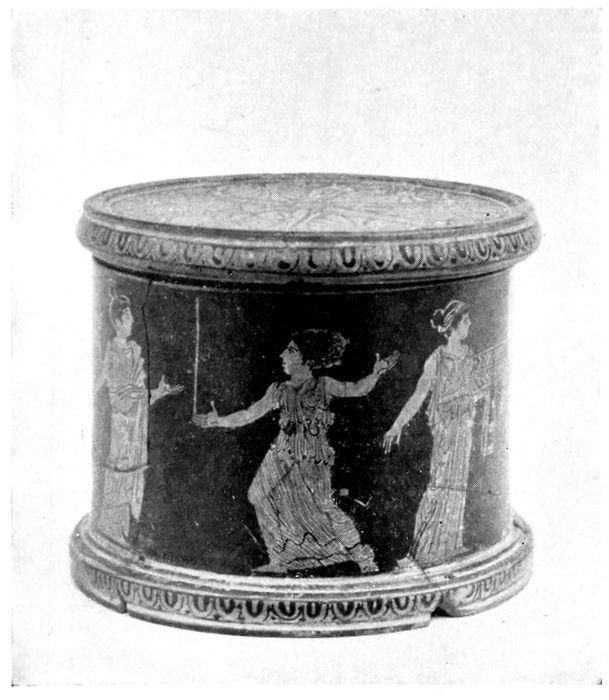
Red-figured pyxis of cylindrical shape and no handle on the lid.
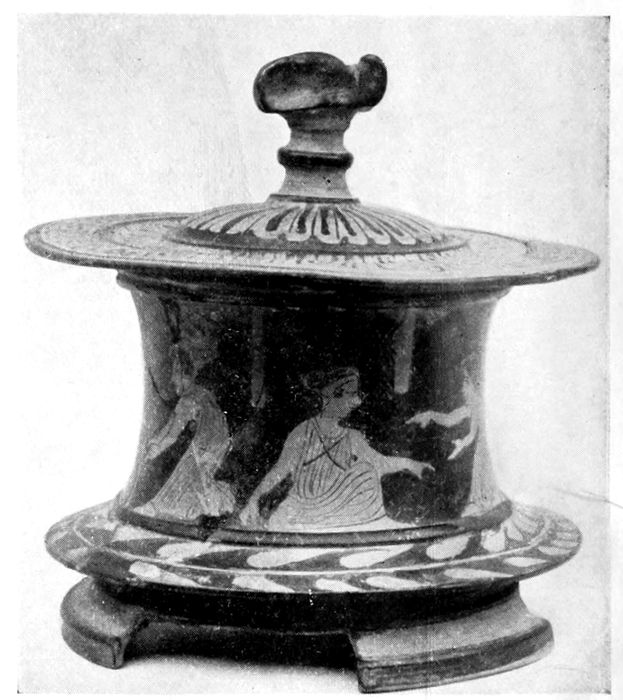
Red-figured pyxis of late date with the knob in the form of a knucklebone.
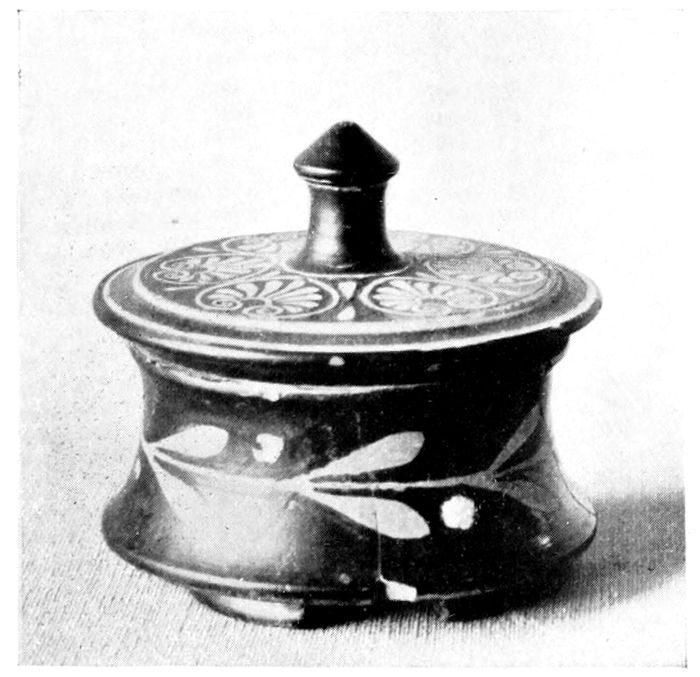
Small pyxis of attractive design delicately worked.
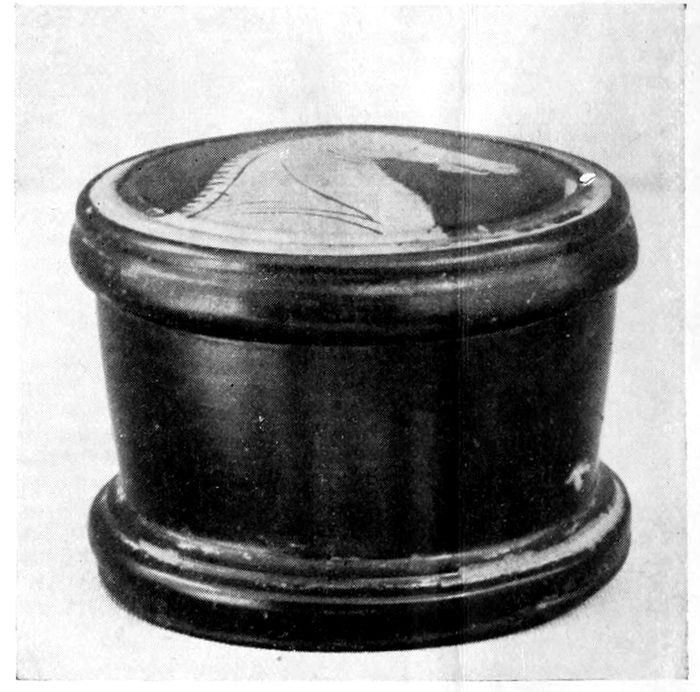
Small cylindrical pyxis without handle.
34ILLUSTRATIONS FROM ATTIC VASES. The theory has often been advanced that the painted black-figured and red-figured vases were made for decoration and for votive and funeral purposes but not for actual use. The following illustrations from Attic vases show some of the best-known types in use in the daily life of the Greeks, and thus furnish us with contemporary evidence that the vases were made to serve the purposes for which they are so well adapted.
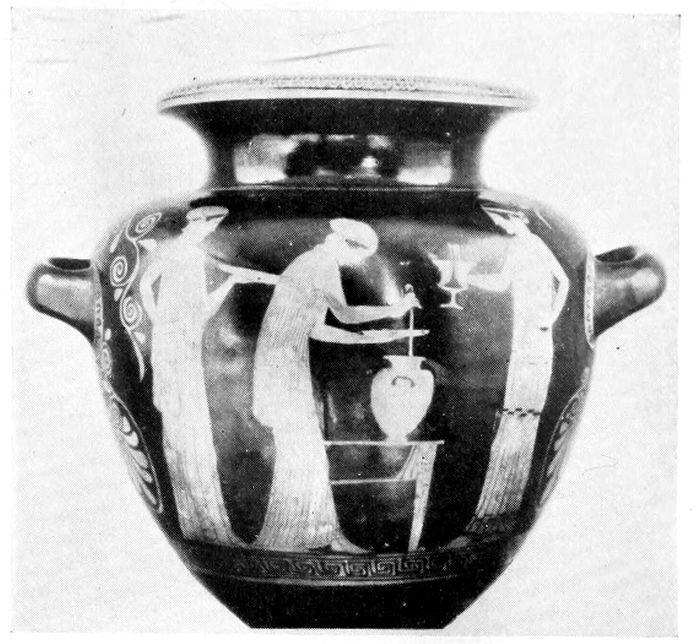
Scene on a red-figured stamnos. Three women are filling cups, a kantharos, and a phiale, from a stamnos placed on a table. The stamnos contains the mixture of wine and water which formed the regular drink of the Greeks.
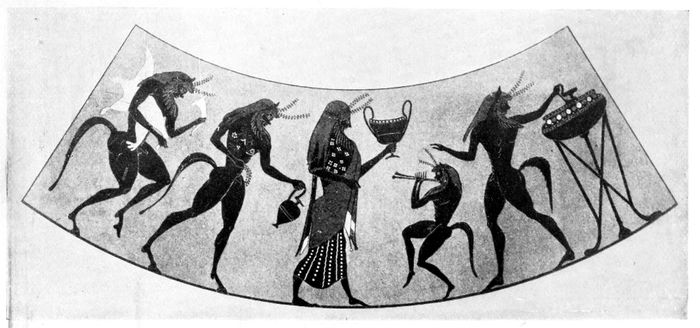
Scene on an Ionic amphora in the collection of the Marquis of Northampton. The god Dionysos and a company of satyrs are drinking and making merry. The wine is in a lebes on a tripod at the right. A satyr is dipping it out with an oinochoë without taking the trouble to use a ladle. Dionysos himself holds up his large kantharos, and the satyr at the left grasps a wine-skin and a drinking-horn.
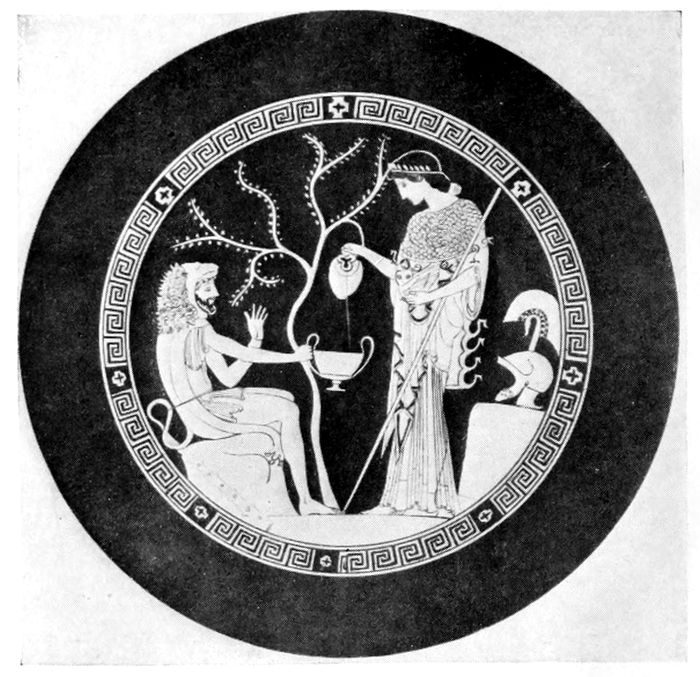
Scene on a red-figured kylix in the Antiquarium, Munich. Herakles, wearied with his labors, is seated on a rock, while Athena, his patroness, pours wine for him from an oinochoë into a kantharos. The trefoil-shaped mouth of the oinochoë can be plainly seen.
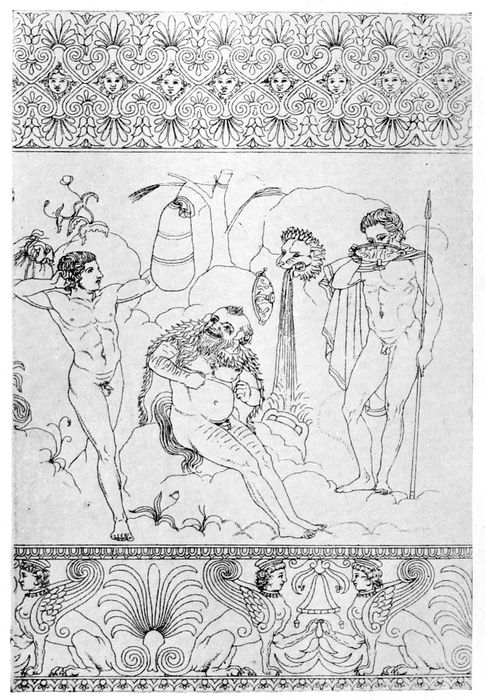
Detail from a scene on the Ficoroni Cista in the Museo Kircheriano in Rome. A young man is drinking from a kylix which he holds by one handle.
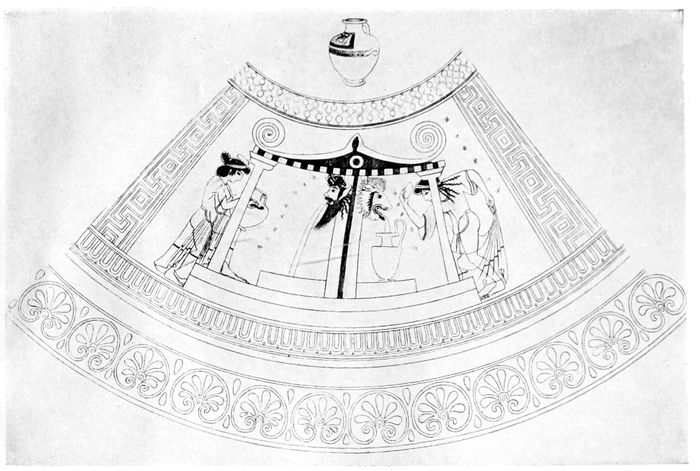
Scene on a hydria in the Torlonia Collection in Rome. Two girls are drawing water at a public fountain into large hydriai or water-jars. The girl at the left is lifting her jar upon her head. The other is putting a little cushion for protection on her head, meanwhile holding her dress away from the water.
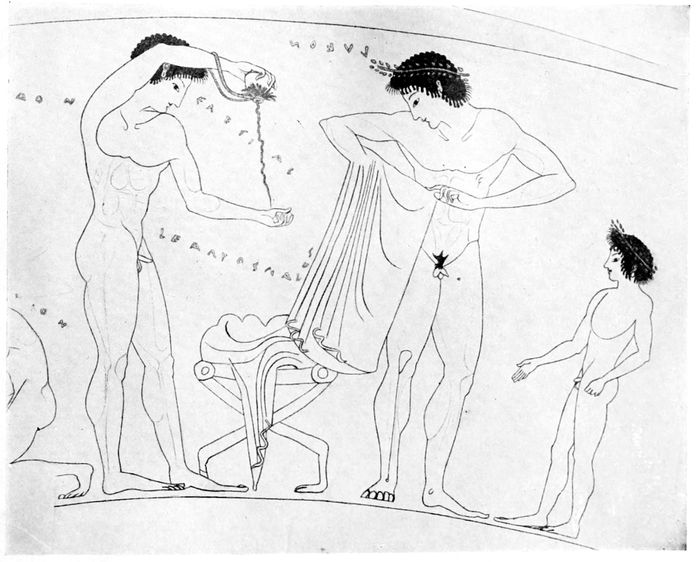
Scene on a red-figured krater in the Antiquarium, Berlin. Two young men are preparing for exercise in a gymnasium. One of them is pouring oil into his hand from an aryballos attached to his wrist by a cord, in order to rub the liquid over his body.
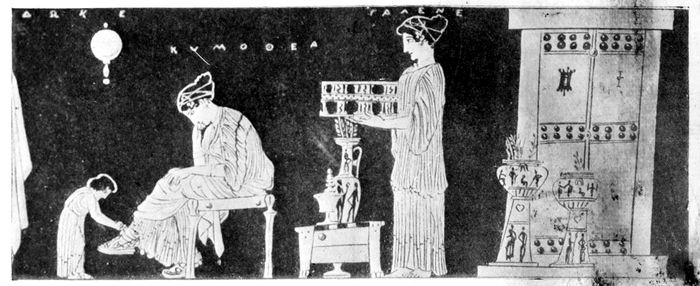
Scene on a red-figured pyxis in the British Museum. A bride is being dressed for her wedding; a little maid is fastening her shoes while another is bringing her jewelry in a box. At the door stand two marriage vases filled with twigs, and a loutrophoros nearby also contains branches or flowers. On a little chest stands a pyxis or perfume vase. A mirror hangs on the wall.
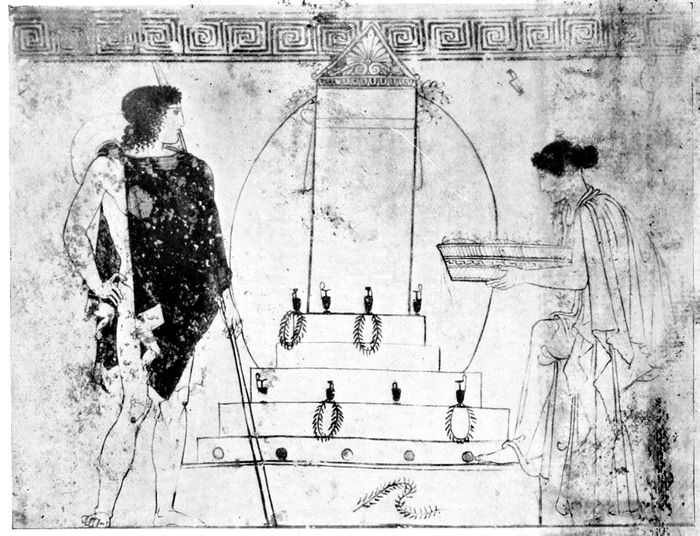
Scene from a polychrome lekythos in the National Museum, Athens. Such lekythoi were made especially for offerings to the dead. This picture shows a woman bringing wreaths in a basket to place on a gravestone on the steps of which are lekythoi and oinochoai. Behind the monument appears the mound over the grave.
End of the Project Gutenberg EBook of Shapes of Greek Vases, by
The Metropolitan Museum of Art
*** END OF THIS PROJECT GUTENBERG EBOOK SHAPES OF GREEK VASES ***
***** This file should be named 59946-h.htm or 59946-h.zip *****
This and all associated files of various formats will be found in:
http://www.gutenberg.org/5/9/9/4/59946/
Produced by Richard Tonsing, Turgut Dincer and the Online
Distributed Proofreading Team at http://www.pgdp.net (This
file was produced from images generously made available
by The Internet Archive)
Updated editions will replace the previous one--the old editions will
be renamed.
Creating the works from print editions not protected by U.S. copyright
law means that no one owns a United States copyright in these works,
so the Foundation (and you!) can copy and distribute it in the United
States without permission and without paying copyright
royalties. Special rules, set forth in the General Terms of Use part
of this license, apply to copying and distributing Project
Gutenberg-tm electronic works to protect the PROJECT GUTENBERG-tm
concept and trademark. Project Gutenberg is a registered trademark,
and may not be used if you charge for the eBooks, unless you receive
specific permission. If you do not charge anything for copies of this
eBook, complying with the rules is very easy. You may use this eBook
for nearly any purpose such as creation of derivative works, reports,
performances and research. They may be modified and printed and given
away--you may do practically ANYTHING in the United States with eBooks
not protected by U.S. copyright law. Redistribution is subject to the
trademark license, especially commercial redistribution.
START: FULL LICENSE
THE FULL PROJECT GUTENBERG LICENSE
PLEASE READ THIS BEFORE YOU DISTRIBUTE OR USE THIS WORK
To protect the Project Gutenberg-tm mission of promoting the free
distribution of electronic works, by using or distributing this work
(or any other work associated in any way with the phrase "Project
Gutenberg"), you agree to comply with all the terms of the Full
Project Gutenberg-tm License available with this file or online at
www.gutenberg.org/license.
Section 1. General Terms of Use and Redistributing Project
Gutenberg-tm electronic works
1.A. By reading or using any part of this Project Gutenberg-tm
electronic work, you indicate that you have read, understand, agree to
and accept all the terms of this license and intellectual property
(trademark/copyright) agreement. If you do not agree to abide by all
the terms of this agreement, you must cease using and return or
destroy all copies of Project Gutenberg-tm electronic works in your
possession. If you paid a fee for obtaining a copy of or access to a
Project Gutenberg-tm electronic work and you do not agree to be bound
by the terms of this agreement, you may obtain a refund from the
person or entity to whom you paid the fee as set forth in paragraph
1.E.8.
1.B. "Project Gutenberg" is a registered trademark. It may only be
used on or associated in any way with an electronic work by people who
agree to be bound by the terms of this agreement. There are a few
things that you can do with most Project Gutenberg-tm electronic works
even without complying with the full terms of this agreement. See
paragraph 1.C below. There are a lot of things you can do with Project
Gutenberg-tm electronic works if you follow the terms of this
agreement and help preserve free future access to Project Gutenberg-tm
electronic works. See paragraph 1.E below.
1.C. The Project Gutenberg Literary Archive Foundation ("the
Foundation" or PGLAF), owns a compilation copyright in the collection
of Project Gutenberg-tm electronic works. Nearly all the individual
works in the collection are in the public domain in the United
States. If an individual work is unprotected by copyright law in the
United States and you are located in the United States, we do not
claim a right to prevent you from copying, distributing, performing,
displaying or creating derivative works based on the work as long as
all references to Project Gutenberg are removed. Of course, we hope
that you will support the Project Gutenberg-tm mission of promoting
free access to electronic works by freely sharing Project Gutenberg-tm
works in compliance with the terms of this agreement for keeping the
Project Gutenberg-tm name associated with the work. You can easily
comply with the terms of this agreement by keeping this work in the
same format with its attached full Project Gutenberg-tm License when
you share it without charge with others.
1.D. The copyright laws of the place where you are located also govern
what you can do with this work. Copyright laws in most countries are
in a constant state of change. If you are outside the United States,
check the laws of your country in addition to the terms of this
agreement before downloading, copying, displaying, performing,
distributing or creating derivative works based on this work or any
other Project Gutenberg-tm work. The Foundation makes no
representations concerning the copyright status of any work in any
country outside the United States.
1.E. Unless you have removed all references to Project Gutenberg:
1.E.1. The following sentence, with active links to, or other
immediate access to, the full Project Gutenberg-tm License must appear
prominently whenever any copy of a Project Gutenberg-tm work (any work
on which the phrase "Project Gutenberg" appears, or with which the
phrase "Project Gutenberg" is associated) is accessed, displayed,
performed, viewed, copied or distributed:
This eBook is for the use of anyone anywhere in the United States and
most other parts of the world at no cost and with almost no
restrictions whatsoever. You may copy it, give it away or re-use it
under the terms of the Project Gutenberg License included with this
eBook or online at www.gutenberg.org. If you are not located in the
United States, you'll have to check the laws of the country where you
are located before using this ebook.
1.E.2. If an individual Project Gutenberg-tm electronic work is
derived from texts not protected by U.S. copyright law (does not
contain a notice indicating that it is posted with permission of the
copyright holder), the work can be copied and distributed to anyone in
the United States without paying any fees or charges. If you are
redistributing or providing access to a work with the phrase "Project
Gutenberg" associated with or appearing on the work, you must comply
either with the requirements of paragraphs 1.E.1 through 1.E.7 or
obtain permission for the use of the work and the Project Gutenberg-tm
trademark as set forth in paragraphs 1.E.8 or 1.E.9.
1.E.3. If an individual Project Gutenberg-tm electronic work is posted
with the permission of the copyright holder, your use and distribution
must comply with both paragraphs 1.E.1 through 1.E.7 and any
additional terms imposed by the copyright holder. Additional terms
will be linked to the Project Gutenberg-tm License for all works
posted with the permission of the copyright holder found at the
beginning of this work.
1.E.4. Do not unlink or detach or remove the full Project Gutenberg-tm
License terms from this work, or any files containing a part of this
work or any other work associated with Project Gutenberg-tm.
1.E.5. Do not copy, display, perform, distribute or redistribute this
electronic work, or any part of this electronic work, without
prominently displaying the sentence set forth in paragraph 1.E.1 with
active links or immediate access to the full terms of the Project
Gutenberg-tm License.
1.E.6. You may convert to and distribute this work in any binary,
compressed, marked up, nonproprietary or proprietary form, including
any word processing or hypertext form. However, if you provide access
to or distribute copies of a Project Gutenberg-tm work in a format
other than "Plain Vanilla ASCII" or other format used in the official
version posted on the official Project Gutenberg-tm web site
(www.gutenberg.org), you must, at no additional cost, fee or expense
to the user, provide a copy, a means of exporting a copy, or a means
of obtaining a copy upon request, of the work in its original "Plain
Vanilla ASCII" or other form. Any alternate format must include the
full Project Gutenberg-tm License as specified in paragraph 1.E.1.
1.E.7. Do not charge a fee for access to, viewing, displaying,
performing, copying or distributing any Project Gutenberg-tm works
unless you comply with paragraph 1.E.8 or 1.E.9.
1.E.8. You may charge a reasonable fee for copies of or providing
access to or distributing Project Gutenberg-tm electronic works
provided that
* You pay a royalty fee of 20% of the gross profits you derive from
the use of Project Gutenberg-tm works calculated using the method
you already use to calculate your applicable taxes. The fee is owed
to the owner of the Project Gutenberg-tm trademark, but he has
agreed to donate royalties under this paragraph to the Project
Gutenberg Literary Archive Foundation. Royalty payments must be paid
within 60 days following each date on which you prepare (or are
legally required to prepare) your periodic tax returns. Royalty
payments should be clearly marked as such and sent to the Project
Gutenberg Literary Archive Foundation at the address specified in
Section 4, "Information about donations to the Project Gutenberg
Literary Archive Foundation."
* You provide a full refund of any money paid by a user who notifies
you in writing (or by e-mail) within 30 days of receipt that s/he
does not agree to the terms of the full Project Gutenberg-tm
License. You must require such a user to return or destroy all
copies of the works possessed in a physical medium and discontinue
all use of and all access to other copies of Project Gutenberg-tm
works.
* You provide, in accordance with paragraph 1.F.3, a full refund of
any money paid for a work or a replacement copy, if a defect in the
electronic work is discovered and reported to you within 90 days of
receipt of the work.
* You comply with all other terms of this agreement for free
distribution of Project Gutenberg-tm works.
1.E.9. If you wish to charge a fee or distribute a Project
Gutenberg-tm electronic work or group of works on different terms than
are set forth in this agreement, you must obtain permission in writing
from both the Project Gutenberg Literary Archive Foundation and The
Project Gutenberg Trademark LLC, the owner of the Project Gutenberg-tm
trademark. Contact the Foundation as set forth in Section 3 below.
1.F.
1.F.1. Project Gutenberg volunteers and employees expend considerable
effort to identify, do copyright research on, transcribe and proofread
works not protected by U.S. copyright law in creating the Project
Gutenberg-tm collection. Despite these efforts, Project Gutenberg-tm
electronic works, and the medium on which they may be stored, may
contain "Defects," such as, but not limited to, incomplete, inaccurate
or corrupt data, transcription errors, a copyright or other
intellectual property infringement, a defective or damaged disk or
other medium, a computer virus, or computer codes that damage or
cannot be read by your equipment.
1.F.2. LIMITED WARRANTY, DISCLAIMER OF DAMAGES - Except for the "Right
of Replacement or Refund" described in paragraph 1.F.3, the Project
Gutenberg Literary Archive Foundation, the owner of the Project
Gutenberg-tm trademark, and any other party distributing a Project
Gutenberg-tm electronic work under this agreement, disclaim all
liability to you for damages, costs and expenses, including legal
fees. YOU AGREE THAT YOU HAVE NO REMEDIES FOR NEGLIGENCE, STRICT
LIABILITY, BREACH OF WARRANTY OR BREACH OF CONTRACT EXCEPT THOSE
PROVIDED IN PARAGRAPH 1.F.3. YOU AGREE THAT THE FOUNDATION, THE
TRADEMARK OWNER, AND ANY DISTRIBUTOR UNDER THIS AGREEMENT WILL NOT BE
LIABLE TO YOU FOR ACTUAL, DIRECT, INDIRECT, CONSEQUENTIAL, PUNITIVE OR
INCIDENTAL DAMAGES EVEN IF YOU GIVE NOTICE OF THE POSSIBILITY OF SUCH
DAMAGE.
1.F.3. LIMITED RIGHT OF REPLACEMENT OR REFUND - If you discover a
defect in this electronic work within 90 days of receiving it, you can
receive a refund of the money (if any) you paid for it by sending a
written explanation to the person you received the work from. If you
received the work on a physical medium, you must return the medium
with your written explanation. The person or entity that provided you
with the defective work may elect to provide a replacement copy in
lieu of a refund. If you received the work electronically, the person
or entity providing it to you may choose to give you a second
opportunity to receive the work electronically in lieu of a refund. If
the second copy is also defective, you may demand a refund in writing
without further opportunities to fix the problem.
1.F.4. Except for the limited right of replacement or refund set forth
in paragraph 1.F.3, this work is provided to you 'AS-IS', WITH NO
OTHER WARRANTIES OF ANY KIND, EXPRESS OR IMPLIED, INCLUDING BUT NOT
LIMITED TO WARRANTIES OF MERCHANTABILITY OR FITNESS FOR ANY PURPOSE.
1.F.5. Some states do not allow disclaimers of certain implied
warranties or the exclusion or limitation of certain types of
damages. If any disclaimer or limitation set forth in this agreement
violates the law of the state applicable to this agreement, the
agreement shall be interpreted to make the maximum disclaimer or
limitation permitted by the applicable state law. The invalidity or
unenforceability of any provision of this agreement shall not void the
remaining provisions.
1.F.6. INDEMNITY - You agree to indemnify and hold the Foundation, the
trademark owner, any agent or employee of the Foundation, anyone
providing copies of Project Gutenberg-tm electronic works in
accordance with this agreement, and any volunteers associated with the
production, promotion and distribution of Project Gutenberg-tm
electronic works, harmless from all liability, costs and expenses,
including legal fees, that arise directly or indirectly from any of
the following which you do or cause to occur: (a) distribution of this
or any Project Gutenberg-tm work, (b) alteration, modification, or
additions or deletions to any Project Gutenberg-tm work, and (c) any
Defect you cause.
Section 2. Information about the Mission of Project Gutenberg-tm
Project Gutenberg-tm is synonymous with the free distribution of
electronic works in formats readable by the widest variety of
computers including obsolete, old, middle-aged and new computers. It
exists because of the efforts of hundreds of volunteers and donations
from people in all walks of life.
Volunteers and financial support to provide volunteers with the
assistance they need are critical to reaching Project Gutenberg-tm's
goals and ensuring that the Project Gutenberg-tm collection will
remain freely available for generations to come. In 2001, the Project
Gutenberg Literary Archive Foundation was created to provide a secure
and permanent future for Project Gutenberg-tm and future
generations. To learn more about the Project Gutenberg Literary
Archive Foundation and how your efforts and donations can help, see
Sections 3 and 4 and the Foundation information page at
www.gutenberg.org
Section 3. Information about the Project Gutenberg Literary Archive Foundation
The Project Gutenberg Literary Archive Foundation is a non profit
501(c)(3) educational corporation organized under the laws of the
state of Mississippi and granted tax exempt status by the Internal
Revenue Service. The Foundation's EIN or federal tax identification
number is 64-6221541. Contributions to the Project Gutenberg Literary
Archive Foundation are tax deductible to the full extent permitted by
U.S. federal laws and your state's laws.
The Foundation's principal office is in Fairbanks, Alaska, with the
mailing address: PO Box 750175, Fairbanks, AK 99775, but its
volunteers and employees are scattered throughout numerous
locations. Its business office is located at 809 North 1500 West, Salt
Lake City, UT 84116, (801) 596-1887. Email contact links and up to
date contact information can be found at the Foundation's web site and
official page at www.gutenberg.org/contact
For additional contact information:
Dr. Gregory B. Newby
Chief Executive and Director
gbnewby@pglaf.org
Section 4. Information about Donations to the Project Gutenberg
Literary Archive Foundation
Project Gutenberg-tm depends upon and cannot survive without wide
spread public support and donations to carry out its mission of
increasing the number of public domain and licensed works that can be
freely distributed in machine readable form accessible by the widest
array of equipment including outdated equipment. Many small donations
($1 to $5,000) are particularly important to maintaining tax exempt
status with the IRS.
The Foundation is committed to complying with the laws regulating
charities and charitable donations in all 50 states of the United
States. Compliance requirements are not uniform and it takes a
considerable effort, much paperwork and many fees to meet and keep up
with these requirements. We do not solicit donations in locations
where we have not received written confirmation of compliance. To SEND
DONATIONS or determine the status of compliance for any particular
state visit www.gutenberg.org/donate
While we cannot and do not solicit contributions from states where we
have not met the solicitation requirements, we know of no prohibition
against accepting unsolicited donations from donors in such states who
approach us with offers to donate.
International donations are gratefully accepted, but we cannot make
any statements concerning tax treatment of donations received from
outside the United States. U.S. laws alone swamp our small staff.
Please check the Project Gutenberg Web pages for current donation
methods and addresses. Donations are accepted in a number of other
ways including checks, online payments and credit card donations. To
donate, please visit: www.gutenberg.org/donate
Section 5. General Information About Project Gutenberg-tm electronic works.
Professor Michael S. Hart was the originator of the Project
Gutenberg-tm concept of a library of electronic works that could be
freely shared with anyone. For forty years, he produced and
distributed Project Gutenberg-tm eBooks with only a loose network of
volunteer support.
Project Gutenberg-tm eBooks are often created from several printed
editions, all of which are confirmed as not protected by copyright in
the U.S. unless a copyright notice is included. Thus, we do not
necessarily keep eBooks in compliance with any particular paper
edition.
Most people start at our Web site which has the main PG search
facility: www.gutenberg.org
This Web site includes information about Project Gutenberg-tm,
including how to make donations to the Project Gutenberg Literary
Archive Foundation, how to help produce our new eBooks, and how to
subscribe to our email newsletter to hear about new eBooks.